|
Tonight was one of those relatively rare wintry nights in Washington, DC, where atmospheric transparency is high while seeing is better than average. With Mars just four days away from opposition - its biannual closest approach to Earth - I couldn't let the opportunity slip. The canopies above my backyard are now sufficiently denuded for me to use a telescope just a few steps from my door, so out I stepped with my TEC 140. The Moon was just about to slip behind my building, and I was hard pressed to get a quick picture. The view was in fact beautifully sharp, what you see above is the only shot I could get. I also managed to get a quick look at Jupiter, where to my surprise it seemed that one moon - near the limb of Jupiter - was far below the orbital plane set by the other moons. I don't think I've seen that before. Eventually, I found a comfortable nook from which to observe Mars. Seeing seemed a good deal better than average tonight, and the outline of the planet was about as sharp and steady as I've ever seen it. I was struck by how much smaller it seemed than it did during its last opposition, two years ago, when it looked only marginally smaller than it did during its perihelic opposition of 2018. Of course, my gear has improved since then, so the views of Mars I've had this year haven't been much worse than those I had in 2020. Still, the planet's apparent diameter is only about 17 arcseconds this year - down from 22.4 in 2020, and a whopping 24.2 in 2018. In fact, not since 2014 has Mars looked so unimposing at opposition.
More important for viewing Mars than the apparent size of the planet or my equipment, however, has been dust. In 2018, I couldn't make out any details on Mars while using my Skywatcher 100ED, and that owed more to a yellow, planet-wide dust storm than the lack of perfect color correction on the refractor. In 2020, Mars was relatively dust-free, and so a deeper shade of red. I was ready then with a pair of telescopes (my dearly departed APM 140 and Takahashi FC-100DC) that were only slightly less capable than those I own today. Now Mars seems dusty and a bit yellowish again, but not as much as it was in 2018. Surface detail has obvious through my TEC 140 and Takahashi FC-100DZ, though not as much as it was in 2020, and the planet's disk is comparatively small. I replaced my APM 140 with the TEC 140ED, and my FC-100DC with the FC100DZ, in large part to prepare for this year's opposition. I'm glad I did, but in making those replacements I've also come to realize that there really are rapidly diminishing returns for costly upgrades in this hobby. Yes, views through the DZ seem marginally better than the ones I enjoyed with my wonderful DC, but from night to night conditions in our atmosphere - and that of Mars - are much more important. Tonight I was again reminded of how trifling differences in performance between optics can be enormously exaggerated in online discussions. It's widely held that high-contrast eyepieces such as the TeleVue Delos will easily outperform zoom eyepieces, including the latest iteration of the Baader Hyperion Zoom. While switching between the zoom eyepiece and the Delos 4.5mm and 6mm eyepieces, however, I found that magnification affected the view far more than the eyepiece I was using. The view seemed just right at around 160x; any more than that, and it got a little blurry. Both the Baader and TeleVue eyepieces provided striking and at times rather complex views of Mare Cimmerium at that magnification, along with flashes of Trivium Charontis and perhaps some other dark regions in the northern hemisphere of Mars. I thought I might have caught some hints of white swaths far to the south, but they were hard to pin down; I fancied they might be clouds. I saw very little to separate the eyepieces, but I eventually found myself settling with the 6mm Delos because of its larger field of view. If pressed I might confess that dark albedo regions were more consistently obvious in the Delos than the Baader Zoom - but that may be only because I expected to see them more clearly in the Delos. One thing's for sure: I'll never again assume that I'm missing out by using the zoom eyepiece as opposed to a Delos, and I'll be a little more careful when reading claims that one premium eyepiece or telescope is clearly superior to another. I hope to have another chance to observe Mars this week, and certainly this month, but if not tonight was a wonderful way to mark the planet's opposition.
0 Comments
For amateur astronomers, two things happen to the atmosphere around this time of year in Washington, DC: in general, transparency improves, and seeing - meaning, of course, stability - deteriorates. Daytime brings deep blues, sunset a beautiful gradient from azure to scarlet, and nighttime brilliant winter stars in a velvet tapestry (when not facing towards the National Mall, at least). At the same time, the stars noticeably twinkle far more than they do in summer, and moments of steady seeing become ever rarer. The muggy, mosquito-plagued nights of summer, when the planets can very occasionally look like little Hubble photos viewed from afar, are now a distant memory. All the same, since keeping this blog I've found autumn to be my favorite time to observe. It's just so much more comfortable being outside, the planets are still high in the sky, and my refractors at least give me a puncher's chance of making out some detail on them, even in nights of mediocre seeing. With that in mind, I stepped out on the 14th, Takahashi in hand, and found a nook near my mostly tree-covered backyard that afforded me a good view of Mars. It was cold by DC standards - around freezing - but my telescope was well acclimated and the view was beautifully sharp. The Martian south pole in particular looked large and sort of smeared; not quite as brilliant as it can, but larger in dimensions. Later, a spectacular set of pictures posted by Peter Gorczynski over at CloudyNights.com revealed the cause: a swirl of clouds around the pole that were barely visible to me in the mediocre seeing. I didn't last long in the cold weather, and over the next week seeing here in DC grew worse - but transparency remained better than average. I decided to test out the Unistellar EVScope 2 on the comparatively few but spectacular deep space objects that are beginning to climb high above the horizon in our late autumn sky. On the 22nd, I marched about 20 minutes uphill from my house to my daughter's school. Its field is now the nearest I know that is not completely saturated with light, and I can only hope it stays that way. It's not hard to haul the EVScope that distance, thanks to the relatively ergonomic backpack it comes with, and I can only emphasize yet again how absurdly easy it is to set up the telescope once I'm in position. It takes no more than a minute to have the EVScope fully aligned and tracking my first target. It quickly and easily hooks into its tripod, immediately connects to my phone, and in just moments aligns with the night sky and slews to my first target. It takes me two or three times longer to set up my refractors on their sample manual mounts, which of course don't have any software at all. Other tracking amounts, even the simplest ones (such as the iOptron AZ Mount Pro I own), require far more steps to set up, and often don't quite align perfectly; it's why I inevitably favor manual mounts when stepping out with my refractors. I'm not sure how Unistellar leapfrogged all the established brands in amateur astronomy by offering a mount that truly is plug and play - but they have, and it's wonderful. After I let the telescope cool down, I turned to the Orion Nebula. In the past, I've tended to focus too much on my phone while the telescope slowly integrated its pictures and the view of my target gradually brightened. This time I favored the eyepiece, which as I've written elsewhere is much improved on the EvScope 2. I now noticed that the eyepiece view seemed much sharper and, to my surprise, three-dimensional than the image on my phone. The dark nebula jutting in front of the familiar crescent of the Orion Nebula, for example, truly looked as though it was in the foreground, and I followed a fascinating zigzag pattern of dark nebulosity weaving across the bright core that mostly washed out in the phone image. The EVScope permits easy if relatively low-resolution astrophotography, but the current iteration at least is really designed for observing. I've complained that using the EVScope is a very different experience from using a traditional telescope, because I've tended to wait around for the images to integrate on my phone. This time, I was glued to the eyepiece - and it really did feel like a proper observing experience. The EVScope 2 improves considerably over its predecessor, and the Unistellar software has continually added new capabilities. Just have a look at the image of the Orion Nebula that I took almost exactly two years ago, and compare it with this week's version. I suspect I could further improve the view through the EVScope 2, and I wonder what it would look like were I truly under a dark sky. Still, I find the progress to be really exciting. Just last night, I learned that Unistellar had released yet another software update: this time to enable planetary observation. I couldn't resist, and marched back to the same field. This time, however, I was a little disappointed. While the telescope for the first time automatically dimmed its images of Jupiter and Mars and showed real details on both worlds, overall the view was of course radically different from what I see through my refractors. While traditional telescopes may not as clearly reveal the cloud bands of Jupiter, for example, they show far finer and subtler detail; far more realistic and impressive coloration; and of course the moons and stars surrounding the planets.
I expected as much, but in the moment I couldn't help but be underwhelmed. Yet while walking home, I considered where the technology might be in another two years. Eventually, I suspect there will be few if any areas where traditional telescopes reign supreme. To me, their greatest value could then lie in the connection they provide to generations of observers stretching back to Galileo: to a history of often-eccentric women and men straining at odd hours to discern barely perceptible truths hidden across unimaginable distances in time and space. There are some things clever software can never replace - not many, perhaps, but some. Autumn came early this year in Washington DC, yet the relative warmth of early autumn lingered well past its usual expiration date. The mosquitoes lingered with it, even if their population fell with the leaves, but overall it's been a gorgeous month in the city. Over the past week, we had three crisp, clear nights with tolerably good seeing and transparency. With the canopies above my yard increasingly bare, I was able to peak through and branches and observe without hauling heavy gear for twenty exhausting minutes. A few nights ago, I rolled out my TEC 140 to observe the Moon and Jupiter. Night comes early at this time of the year, of course, so I made it outside before my six-year-old daughter's bedtime. I asked her to join me, and when she did she was thrilled to make out craters on the Moon and, with some difficulty, cloud bands on Jupiter. To my surprise, those were unusually difficult to make out. The sky had a milky quality around bright objects, a kind of watercolor softness, that seemed to obscure detail on the likes of Jupiter. Still, a memorable experience for daughter and daddy alike. On November 8th, conditions promised to be marginally better, and temperatures were just about ideal. This time, I stepped out with a much lighter setup: my Takahashi FC-100DZ, clamped to the CT-20 mount that I'd screwed into my Berlebach Uni tripod. It's a more robust outfit than I take to the local park, but it's still easy to move all in one go. A quick aside: the exceptional weight of the DM-6 mount can make it really sturdy and capable of handling surprisingly hefty telescopes. Yet it also ruins the portability of my TEC 140. The mount feels at least as heavy as the telescope, and when yoked to a tripod it's a chore to move even without the telescope attached. Another problem is that attaching the telescope to the DM-6 mount is a heart-stopping experience in the dark. It's hard to be sure that the dovetail is actually in the clamp, and I've now been unpleasantly surprised several times when the telescope suddenly lurched down after I thought I'd got it in. I live in fear that on some sad night I'll misjudge it, step away, and watch in horror as the telescope crashes to the ground. I have no such problem with the Takahashi. Yet the lightness of the CT-20 mount does mean that the telescope tends to tilt - even when perfectly balanced - if objects are too close to zenith. The CT-20 has an answer, however: it's easy to adjust the tension in the altitude and azimuth axes. This can mean that there's too much tension to easily nudge the telescope along when observing objects that are high up in the sky, but I'll take the tradeoff: less weight and less hassle is worth some compromise. In any case, the Takahashi gave me some very satisfactory views of the waning but still nearly full Moon. The view along the emerging terminator in particular was quite striking, while the Moon's fully illuminated surface showed a mesmerizing swirl of subtle grey shadings. The rays streaking from Tycho, one of the youngest big craters on the lunar surface, are always impressive when the Moon is this close to full. Yet Mars is now wheeling towards its biannual opposition, so of course it stole the show. The planet is quite high in the sky by around 10 PM EST, and it's already brighter than any celestial body visible at that time save Jupiter and the Moon. I feel that its color even by naked eye is not quite as blood-red as it was two years ago; it's paler and a little closer to orange. The Takahashi revealed its waxing globe, but showed considerably less contrast than I could make out a couple years back. In moments of good seeing I could make out the south polar icecap, and then a dark albedo swirl around the ice, interrupted by lighter land before continuing towards the north. Yet the view was anything but sharp, and the planet seemed unsteady somehow in the mediocre seeing. Part of the problem is that much of Mars is currently obscured by bright dust storm: a common if frustrating occurrence when Mars makes a close approach to the Sun. It was to gain a clearer view of the Moon and Mars that I stepped out last night with the TEC 140. Conditions seemed about the same, except it was colder and the reappearance of a halo around the Moon suggested that transparency would be lower. The TEC takes meaningly longer to cool down than the Takahashi, although in both cases the Delos eyepieces take longer to acclimate than the telescopes. I'm not sure it's widely understood that compound eyepieces take longer to cool down than, say, Plossl eyepieces - but that's certainly been my experience, and it does stand to reason. There's just a lot of glass in those things.
In any case, both refractors and their eyepieces need only a few minutes to give acceptable views, even if they do take longer to fully acclimate. When everything was ready I was surprised to find that the TEC 140 actually provided slightly softer views than the Takahashi did the other night, even if contrast on Mars in particular seemed just a bit higher, and the Moon's terminator at times snapped into exquisite if fleeting focus. I was once again impressed by the Takahashi; despite its compact size, I rarely feel I'm missing out when I use that telescope, the way I did with many other small telescopes I've owned. It punches far above it weight. Yet to me the bigger takeaway was that the difference between telescopes is often completely swamped by atmospheric conditions. In mediocre seeing and transparency, there really isn't much of a divide between the $8000 (!) TEC 140 and the $3000 Takahashi (of course both telescopes have world-class optics; even in bad seeing, I would suspect a meaningful difference between them and a run-of-the-mill refractor). In my years of observing here in DC, I can probably count on one hand the nights on which the atmosphere was so stable and clear that I could use magnifications of 200x or more. The pricey difference between optics is often less apparent here than it would be elsewhere, and I think that's something observers should acknowledge more often. Where you live will dictate the gains you get by spending more on bigger and fancier telescopes. William Sheehan - who publishes some of the most engaging books on the history and practice of planetary and lunar observing - writes that as an observer views Mars near opposition, "over it, intermittently, uncertain details dart and then are gone like doubtful visions." None other than Percival Lowell - a key popularizer of the Mars canal theory, among other things - coined the term "revelation peeps" to describe these sudden glimpses of intricate detail. That is precisely what Mars had on offer tonight. It wobbled and wavered, like a coin seen through the burbling water of a fountain. Then, for fractions of a second, it snapped into sharp relief, looking really and truly like a planet seen from an approaching spaceship. Just before my brain could grapple with that new reality, the planet reverted so quickly to an indistinct blob that I could scarcely believe it had ever been otherwise. Mars! Always so difficult, but oh so compelling. The planets are all lined up in the early morning sky, and the summer atmosphere here in DC can really settle down at night. The Sun begins to rise at around 5 AM, however, so getting up early enough to see the planets means sacrificing sleep. Still, I couldn't resist setting out twice, over the past few weeks, to catch glimpse of Mars, Jupiter, and Saturn. First, on June 25th, I marched over to a nearby soccer field with my Takahashi in hand. Seeing with supposed to be better than average, while transparency was a little worse. When I set up, however, I realized that the atmosphere was actually surprisingly turbulent around the eastern horizon. That kept me from getting a good view of either Jupiter or Mars, which was quite disappointing given how tired I was. When I swung the refractor over to Saturn, however, I realized that the atmosphere was better towards the south. I had a really nice, crisp view of the planet and its rings before wisps of high-altitude cloud convinced me to pack up. A few days later, I celebrated my daughter's sixth birthday. While hauling stuff to her party, I realized that a little wagon would really help. It also dawned on me that a big enough wagon could carry my TEC 140, together with its tripod, mount, and eyepieces. I pulled the trigger and bought a UIDYGGD Folding Wagon, hoping that I could use it to haul my biggest telescope to a nearby field. In summer the leaves are just too thick, and the streetlights are just too bright, to use the TEC 140 in or near my backyard.
On the early morning of July 11th, I loaded everything into the wagon and began to wheel it towards the field. After about thirty seconds of hauling, I nearly gave up. I was dragging everything uphill, and my back was on fire. I paused, then persisted - and after fifteen minutes, reached the field. It occurred to me that there was no way I could have made it there while holding my telescope case in one hand, and pulling my rolling suitcase - which stores my tripod, mount, and eyepieces - in the other. After I set up, I turned to Mars and was rewarded with easily my best view of the planet this year. Not only was the south polar cap clearly visible, but so was a latticework of dark albedo features spidering up towards the planet's equator. Turning, to Jupiter, I was delighted to see the shadow of a Galilean moon, just beginning to emerge onto the planet's western limb. This time seeing really was better then average. It seemed there were more cloud belts than I could easily count, and there was that sensation of infinitely intricate detail that the clouds can have when Earth's atmosphere is sufficiently stable. Saturn, however, again stole the show. I've never had a view of Saturn using the TEC 140 that was quite as good as those I've enjoyed of Mars or Jupiter. But this time, with Saturn fairly high in the sky, I was treated to perhaps the sharpest view I've ever had of the planet. Not only was the Cassini Division plainly visible for the entire length of the rings, but I could make out multiple rings - which is rare for me -and the shadow of the rings on the planet was a perfect, velvet black. I also made out a whole slew of moons, and beautifully detailed, turbulent clouds on the planet's creamy yellow-white disk. It was a view that fully justified my lack of sleep - in fact, one of the best views I've ever had of a planet. I usually prefer viewing Jupiter and Mars to Saturn, because the appearance of the closer planets changes much more than that of Saturn. But when the atmosphere cooperates, the night sky offers nothing more beautiful - or more hauntingly alien - than Saturn and its rings. Summer has truly begun in DC when the forecast calls for back-to-back nights with good seeing, and the planets begin to rise high above the horizon. After a very satisfying morning with my Takahashi FC-100DZ, gazing at the southern icecap of Mars, I hauled out my TEC 140 last night and found the same gap in the trees. Once again, there were Mars and Jupiter in the pellucid morning sky, in good (if not exactly great) seeing. I'd swapped my DM-4 mount for a DM-6, and my carbon fiber tripod for a Berlebach Uni. The heavier ensemble is much more pleasant to use. As I've written in these pages, there's just not beating the mechanical quality of TEC. Every aspect of the 140 is a joy to see and a pleasure to manipulate. The DM-6 and Uni hold the telescope exceptionally well, with virtually no vibrations even when I adjust the buttery-smooth Feathertouch focuser. If I could have just one setup: yes, it would be this. I've often found an easily noticeable difference at the eyepiece between quality 4- and 5.5-inch refractors. The TEC in particular has given me my finest-ever views of Jupiter and the Moon, with an ethereal, three-dimensional quality and the sensation of texture that I've never had with another telescope. This morning, however, I was mildly surprised to find that the view resembled what I'd seen the previous morning, using the FC-100DZ. Granted, I could see a star near Mars that I hadn't sighted with the smaller refractor, and the cloud belts of Jupiter definitely showed more detail in moments of steady seeing. At well over 200x, a dark albedo feature on Mars seemed to more clearly extend north from the southern icecap, which of course I could make out clearly. Yet the difference was, overall, insubstantial. I think amateur astronomers too often exaggerate the importance of equipment in what they can discern at the eyepiece, and too often understate the influence of the atmosphere. In my experience, even subtle atmospheric differences from night to night - and from one part of the sky to the other - can matter more than very substantial differences in equipment (that might make one setup cost many thousands of dollars more than another). It's humbling to know that a $150 telescope - such as the C90 - could outperform an $8000 refractor (such as the TEC 140) on any given night. I also wonder to what extent nearby streetlights were running interference, softening the view at the eyepiece. Something like that seems to have happened to me before, when my FC-100DC suddenly showed garish chromatic aberration as I observed the Moon under some bright lights. In any case, several dark markings - barges? - were fleetingly visible in what I took to be the north equatorial and north temperate cloud belts of Jupiter. I was again struck by the pale and almost washed-out view of the planet, where contrast has often seemed so stark with a 5.5-inch refractor. I thought I could make out a very faded Great Red Spot: not much more than a subtle blotch in the planet's southern hemisphere. After I packed up, I reflected on a recent trip to some astronomical archives, which I consulted to complete my next book, Ripples in the Cosmic Ocean. Among other stops, my travels took me to the archive of the Royal Astronomical Society of Canada, which is tucked away in a little office on the second-story of a nondescript building in Toronto. There's a heap of telescopes in the middle of the archive, and the Society's wonderful archivist explained to me that all of them, in various ways, tell the history of astronomy in Canada. He hopes to mount them in a museum - and indeed I drooled over some fascinating pieces. One I found particularly striking: a beautifully-preserved little telescope - is it 40, maybe 50mm across? - used by satellite-trackers in Operation Moonwatch, amid the paranoia that accompanied the early Space Age. The mechanical quality really impressed me - the tabletop tripod alone was a diminutive masterpiece - and I wondered what the optics could reveal. I'll bet today's amateurs would pay through the nose for a travel scope like this one. I visited the archive to look over some astronomical logbooks, and as usual those were a treat. It can be viscerally moving to read over another amateur's drawings and reflections from decades or centuries ago. Our world has changed - and sometimes other worlds have, too - but there's a common thread: the long-dead observer and I both gazed with wonder at something that's far bigger than our fleeting lives. We struggle to put in words what it means for us, as we obsess over equipment and traces of detail in planetary disks. We are the Universe, conscious of itself - but only briefly. The planets are rising high above the early morning horizon, and for once the forecast called for good seeing. I slept fitfully until 4:15 AM, nearly convinced myself to fall back asleep, and finally slipped out the back door at 4:45. I soon found that I couldn't see a planet from my backyard, but I did find a spot nearby where a gap in the trees revealed two brilliant planets. They were remarkably close together - not much more than Jupiter and Venus were about a month ago. With the Sun beginning to brighten the morning sky, I set up my Takahashi and targeted the brightest of those planets. At first, I thought it must be Venus - that's how bright it was - and I assumed the less brilliant, yellowish planet was Jupiter. For a minute or two I thought my finderscope must be misaligned. I kept targeting the brightest planet, and time and again Jupiter showed up in the eyepiece. Finally, it dawned on me - a little later than it might have, had I had more sleep - that in fact the brilliant planet was Jupiter. I was astonished to find that the dimmer - but still very bright - planet was Mars. It's so much brighter now than it was just a month ago - and that, of course, means that it's fast approaching Earth. I was a little disappointed upon observing Jupiter. Towards the eastern horizon, the seeing was a little worse than I'd expected, and although I could make out many salmon-colored belts, shimmering in the tremulous atmosphere, the planet seemed a little washed out. It lacked the vivid reds and ochres that sometimes create such striking contrast on Jupiter. At just over 200x the Galilean moons were tiny disks, but without obvious differences in color. Mars, by contrast, was a deeper red than I've normally seen it. For the first time in two years, I made out a polar icecap - this one the southern icecap - and a dark ring around it that was, in the late nineteenth century, widely assumed to be meltwater lake draining off the cap. I could also discern dark streaks shooting up towards the Martian equator. In the nineteenth century, many astronomers - not just Percival Lowell - figured that these were canals and oases channelling polar meltwater towards cultivated fields. That was how the Martians were thought to cling to life on a drying and cooling world.
Mars is my favorite planet to observe when it nears its biannual opposition (and it's free of planet-encircling dust storms). This morning reminded me of the morning of June 9th, 2020, when I observed Mars for the first time through my FC-100DC, as it began to approach Earth that year. That morning, I was stunned to discern the southern icecap for the first time, along with dark albedo features that had never been visible to me before. It excited me to no end to realize how much more could be visible as the planet wheeled closer and closer to Earth that fall. I have much the same feeling now. I truly can't wait to see what Mars will bring this year. I wonder what I'll be able to glimpse with telescopes that are a little better than those I had in 2020. It has, to put it mildly, been an eventful ten weeks since I last wrote in this journal. We endured a sustained effort to subvert democracy and a frightening insurrection in the midst of what - we hope - was the worst stretch of a once-in-a-century pandemic . . . and then, at long last, we exhaled with the return of decency and competency to the White House. There were nights I was too consumed by the news to take out a telescope, believe it or not. But the bigger reason for the lack of updates here has been the atmosphere. For months it has been every bit as turbulent as the politics in this city; in fact, I don't think we've had a night of good seeing since early November. I took out my Takahashi FC-100DZ a couple times, if only to catch a glimpse of Mars before it grew too small for detailed observation. While I caught a glimpse of those dark albedo features and even the southern ice cap, the planet is now too small for the kind of views that dazzled me last summer and fall - and the seeing never really brought it all into focus. On the night of January 12th, with our observation deck deserted, I did manage to haul the Takahashi and my TV 85 to the rooftop. Since I swapped my FC-100DC for the DZ primarily to obtain the best-possible views of Mars, I thought I'd compare the view through the Takahashi with what I could get using the TV 85. As I've written in these pages, the TV 85 offers gloriously high-contrast views, but its color correction is supposed to lag behind that of the Takahashi refractors, especially the DZ.
So, was the view very different? Well, the seeing was awful, so that hampered the comparison . . . and my red dot finders abruptly stopped working, which made it much harder to quickly compare the views. Then I discovered, to my surprise, that my AYO II mount has developed a little slippage, especially when holding two telescopes. Is it time to look for a new medium mount? In any case, I did eventually get a chance to observe Mars through both telescopes. I thought that perhaps I could make out a little more detail with the DZ, but the seeing was so bad and the usable magnification so low that I couldn't be sure. I was, however, struck by the difference in color. Mars was much redder through the TV 85, and the planet's colors looked more accurate, more natural using the DZ. To me, at least, that's roughly synonymous with "better." The difference was big enough that I can't really imagine using the TV 85 over the DZ for planetary observation, even in bad seeing and cold weather. In any case, I have some tinkering to do before using either telescope again; new finders and perhaps a new mount may be in order. On November 16th, the sky was clear and, after a glorious sunset, atmospheric seeing promised to be mediocre but transparency was predicted to be superb. With no Moon in the sky, conditions were right to take the EVScope for another spin. I've now (separately) purchased the backpack that's sold with the EVScope; my rolling case, I suspect, my knock the telescope out of alignment. When I set it up this time, collimation was just about perfect. I made a couple tiny tweaks - again, this took seconds - and then rapidly achieved fine focus with the built-in Bahtinov mask. It was cold and I was exhausted, so I figured I would only take two ten-minute exposures of the Andromeda and Triangulum galaxies. Moments after the telescope slewed to Andromeda, I heard some rustling in the distance and noticed a dim orange glow, appearing and disappearing. Then the sounds of muttering wafted over on the breeze. It seemed I was sharing my park - and I had the disquieting feeling that I was being observed. After about eight minutes or so, I thought a third shadow joined the two in the distance, and then the rustling got closer. The conversation, it seemed, was definitely in Russian. Suddenly a flashlight turned on; there were three people, and they were walking directly towards me. I greeted them: "Hello? Hi!". At that, one of them exclaimed "oh my God!", and then all three of them darted to the side, behind a bush, and disappeared. The sounds receded into the distance. That was unsettling. Fortunately, after ten minutes the Andromeda exposure turned out nicely, considering the light pollution. Collimation and fine alignment really makes for much tighter stars and far better images, though I imagine things would be better still in superior seeing (and, of course, under a darker sky). Now it was on to Triangulum. It wasn't long ago that I managed to spot the galaxy with the FC-100DC, under darker skies some distance from DC. I noticed only a slight brightening of the sky, with averted vision, in what I could just perceive - or imagine - to be a spiral pattern. Clearly observing the galaxy now, from downtown, is a particular thrill. I don't know why, but Triangulum in particular has always captured my imagination. Maybe it's because it gets so little attention compared to the two giants of our Local Group of galaxies, or maybe because it's a face-on galaxy with distinctly knotted spiral arms . . . I'm not sure why, exactly. In any case, I find that the EVScope does a particularly good job on this galaxy (see above). And again, during the exposure I was in for a shock. With a loud thump and a lot of growing, a rabbit suddenly rushed right by the telescope, a fox in hot pursuit. The fox stopped short of my location with a snarl, then scampered - its little legs a blur - over a hill and behind a bush. Both fox and rabbit were no more than six feet from me. I couldn't wait to tell my four-year-old daughter in the morning. Anyway, after a few more minutes the Triangulum exposure was done to my satisfaction. I packed up the telescope, warmed my chilled fingers, and walked home. Suffice it to say, I've really started to enjoy the EVScope. A few days after my strange night with the EVScope, an ad appeared on AstroMart that forced me into hours of tortured thought (usually while attempting to get my one-year-old to sleep). Here was a Takahashi FC-100DZ, used only once and in pristine condition. As I've mentioned before, this year I've been tempted to swap my 100DC for a DZ. The DZ has better color correction and its optics might be marginally sharper, on average, though both improvements may be difficult to detect visually (I read many opinions, and they seem to differ). You can read a great breakdown of the relative merits of the four current FC-100 models here. I've resisted the urge to swap the DC for the DZ because, first, the hassle and expense seemed daunting, and second, the DC's weight is supposed to be lighter. The difference in weight, I concluded, outweighed (sorry) the marginal difference in optical quality. Yet the four-inch refractor is my most used telescope, and now I couldn't resist the urge to upgrade to maybe the finest refractor of this size ever made. So, I bought the DZ and sold my DC (along with some other stuff to make up the cost). I have to say, the comparison between DC and DZ surprised me in a few ways that aren't covered elsewhere. First and for my purposes most importantly, the weight difference between the two telescopes is scarcely noticeable. In the above pictures, you can see the DZ in a configuration for short-range, daytime viewing. However, to reach focus for astronomical viewing you must detach one of the couplings, and that makes the DZ noticeably lighter. It is then also more compact than the DZ when the sliding dew shield is tucked over the optical tube. Second, the most important couplings of the DZ do not screw apart but rather use thumbscrews and compression rings. You can also use that system to attach a diagonal, and I can't tell you what a difference it makes. I actually detest the Takahashi fetish for stacking screwable couplings in the visual back. The couplings, I've found, tend to stick together, and they're not wide enough to grip easily. It's easy to damage them (cosmetically) by applying too much pressure (I did as much to one of the DC's couplings). The new system brings the DZ in line with most other fine refractors, and it is just such a relief. Third, to balance the telescope - using just about any eyepiece - the clamshell tube holder must sit farther from the visual back than it does with the DC. This may seem like a very minor detail, but it provides more room for a red dot finder (RDF) just in front of the visual back. My Rigel QuikFinder RDF is now in a more comfortable position, and it's those little details that can make a real difference in the field. Fourth, the focuser is just a bit nice. Its knobs are metal - not plastic, as in the DC - and the feel is a bit smoother (though I did need to adjust the tension knob for my big Delos eyepieces). I sold Takahashi's two-speed focuser upgrade with the DC, and although I will no doubt miss the fine focus on the DZ, I didn't like how the two-speed add-on left some daylight around the gear housing. On the DZ, I'll stick with the stock focuser. That focuser, by the way, allows me to reach focus with all my eyepieces - something that was just out of reach for the DC. Finally, although the sliding dew shield is very smooth and easy to use, its tightening screw does leave a subtle mark on the optical tube that is noticeable when the dew shied is deployed. I wonder if the previous owner tightened the screw a bit too much, but I doubt it; I think this is just a natural consequence of the technology. It only matters if you're obsessive about the condition of your equipment - but Takahashi telescopes are so beautiful that they tend to bring out that obsession. Last night, and against my better judgement, I took out the DZ for the first time. I say "against my better judgement" because transparency was mediocre and seeing was poor. It's a recipe for disappointment to take out a new telescope in such conditions. I couldn't resist, but I did set up near the cathedral, closer to my house so I could hurry back if observing disappointed.
And did it? Well, a look at Mars did clearly reveal that the atmosphere would not be my friend tonight. And yet, I could plainly make out no fewer than three large dark albedo markings, along with that brilliant south polar icecap. Turning elsewhere, Rigel A and B were laughably easy to split in the poor seeing, and Orion was beautiful even before it emerged from the light pollution near the horizon. So could I make out an optical difference between the DC and DZ? Not after one night of poor seeing. Mars did seem a bit yellower than it does through the DC, and certainly I could detect absolutely no hint of false color in or out of focus. I'm excited to study the Moon, for example, on a really good night. Yet I don't expect a large or even a plainly noticeable difference. I bought the DZ primarily so I could be absolutely sure that the optical quality of my most-used telescope would never hold back my observations - and so that I would never wonder what something would look like with a slightly better telescope of the same design. It's a tiny thing, but after a while tiny things start to matter a whole lot in amateur astronomy. We've enjoyed maybe the best stretch of clear nights with good seeing that I've experienced since moving to Washington, DC, and I was out nearly every night with a telescope in hand. Between work, childcare, and observing, I had no chance to update this blog - but now it's raining, and I have an hour (but just an hour) to relax. Roughly two weeks ago, I spotted a Takahashi FS-102 for sale on Astromart. Amateur astronomers will know that this is a four-inch refractor with a well-earned reputation for exceptional optics. It's been replaced by the Takahashi FC-100 series, and I already own a telescope in that line. But the FS-102, while much bulkier than my 100DC, does better at longer wavelengths. And in Mars-watching season, that's what I convinced myself I needed. Although the FS-102 was supposedly in pristine condition, when it arrived I was dismayed to discover that the lens cell was loose and the tube was covered - I mean covered - with scratches. Luckily, the owner was mortified when I informed him, and I received a (nearly) full refund. I now had some cash to spare, and at just that moment a new copy of Sky and Telescope arrived. A favorable review of the EVScope convinced me to give that telescope another chance (see a previous entry for my first impressions). Maybe the buggy version I owned before had unfairly soured me on the product? It did, after all, offer me a chance to observe nebulae and galaxies I would otherwise never have a chance to see from the city . . . . After it arrived, I bundled the telescope into a suitcase and rolled it along to my nearby park. After I turned it on, it just about instantly figured out where it was and slewed (quietly) to any object in the sky, like magic. Clearly, I'd been sold a glitchy version the first time around. This was more like it! And when I tapped on "enhanced vision" (I describe the technology in a previous entry), the effect was really satisfying. After a couple minutes gathering light on the Andromeda Galaxy, for example, dust lanes I'd previously spotted only with averted vision clearly snapped into focus. So, how good are the views? Well: although I managed to achieve fine focus, I think I'll need to collimate the telescope when I'm next out. Stars are not exactly pinpoints, as these images attest, and that's also caused by a tendency of the telescope to move too much while it's gathering and stacking images. There's more noise in the pictures than I'd prefer, and after getting used to my wonderful TeleVue eyepieces, the view through the EVScope's "eyepiece" is really cramped. It's like looking through a tunnel. More importantly: no, seeing an image through a grainy screen is just not at all the same as seeing it through an optical eyepiece. An optical telescope feels like an extension of the eye; not so the digital EVScope. But damn, it's cool to see galaxies shimmer into view on my iPhone screen. It's simply true that I can see things now that I never would have imagined seeing before, and isn't that what this is all about? I mean, the Triangulum Galaxy from an urban sky . . . are you kidding me? I'm still learning how to use this technology, and pictures I've seen online tell me there's plenty of room for improvement. Still, I've noticed that the images look much more spectacular in the app, while I'm in the field, than they do after I get home. Certainly they pale in comparison to even half-decent astrophotographs made with dedicated gear. Now does the technology always work seamlessly. Just a couple nights ago, I had to restart the telescope and reinstall the software before I could get the enhanced vision mode to work, and by then I'd already shivered outside for about 30 minutes. Some objects also look immeasurably better through my optical telescopes. The EVScope is just about useless for lunar and planetary views, and stars look like ugly blobs compared to the beautiful diamonds they resemble through my refractor. Yet what the EVScope does so well is find that sweet spot between visual observation and astrophotography, and it does so in an integrated package that's usually a pleasure to use. No, I never had the thrill of seeing something with my own eyes - the thrill I've described often in these pages - but I certainly did get a deep sense of pleasure when I glimpsed the Whirlpool Galaxy from the city. One virtue of the EVScope is its weight. If I stuff the EVScope into the suitcase I used for the APM - which, admittedly, does seem to mess with its collimation - then I can easily sling my Takahashi 60Q over my shoulder (and wedge its tripod in the suitcase). I've now used the 60Q twice, including once in the early morning, with the EVScope gathering Orion's light. I have to say: I was more than a little stunned by its quality. To my astonishment, the Moon through the 60Q really didn't look any dimmer than it does through the TV 85, and details were equally sharp. Here are three images I took of the Moon over the last week, with the 60Q, the FC-100DC, and the APM 140. A reminder: the 60Q has an aperture of about 2.5 inches; the 100DC of 4 inches, and the APM of 5.5 inches (these are big differences for refractors). The optical quality of each telescope is roughly similar, though I'd say the APM shows the most false color, and the 60Q the least. That's the 60Q on the left, and the APM on the right. The comparison isn't quite fair; seeing and transparency differed on each night - it was average when I used the APM, and decidedly better than average when I used the 60Q and 100DC - and while the smaller telescopes had fully cooled down when I took these images, the APM in my judgement had not. Still, it amazes me how slight the differences are. I have a new phone, by the way, with a much better camera, and I think it shows. These pictures were taken after the APM had fully acclimated, and I think it's fair to say that now the aperture difference is more easily visible. There's a deeper and more richly textured quality to these images than there is to the 60Q closeup above. Yet it always takes me aback to realize that, when telescopes are of similar quality, differences from night to night on bright objects - the Moon especially - owe more to atmospheric conditions than anything else, including aperture. It's different for dimmer objects. I can usually see at least five stars in the Trapezium using the APM, for example, but I've rarely if ever confidently spotted a fifth with any other refractor. Mars was full of detail when I observed it with the APM - wow that south polar cap looks bright and sharply defined right now - but I found that it, and every other bright object, was surrounded by a bright halo that night. This seems to be a common and very annoying optical effect in the skies of Washington, DC. On two nights with the 100DC, however, I had no such problem. Dark albedo markings were wonderfully detailed, and I spent easily an hour both nights just enjoying the view. It's a little sad to think that every night brings us a little farther from the red planet, but the view should dazzle for months to come. One last note. My first night out with the 100DC over these past two weeks was November 3rd. I suddenly resolved to stop doom scrolling and instead do something that distracted me. But what a sinking feeling I felt, walking bewildered to the field, with panicked screams - yes, screams - echoing around me. I walked out on the 4th, too, and the mood was lighter. Then, on the 7th, while playing with my kids in the very spot I usually set up my telescopes, came the good news: the networks had called it for Biden. I'll never forget the scenes of spontaneous joy on the streets: the bells ringing, cars honking, crowds cheering. We may be in for some very dark months this winter, but that was a moment I'll long remember. After selling my EVScope recently - you can read more about that choice below - I sold a few other items and wound up with a nice chunk of change. I started feeling a familiar temptation, one I've described often in these pages. Should I buy a big telescope that, yes, wouldn't cool down quickly enough to use outside of summer, and yes, might struggle with dew or collimation, but - but! - if conditions were just right, could show me more of the universe than my refractors currently reveal? One option after another came to mind as I struggled to settle my one-year-old at night, and one after another I knocked them down. Visions of what I might see with a much bigger telescope clashed with visions of that telescope gathering dust in my closet while I walked out the door with another small refractor. The truth is, I have to walk too far and observe too quickly for anything other than a refractor to make much sense (except perhaps a Hubble Optics reflector, but I worried about setup time). In the end, I decided to double down on what I already have, and add a little variety to my refractor lineup. I really wanted a telescope that's even more portable than my TV-85, for nights I'm feeling tired, want to go further afield, or don't have enough faith in the atmosphere to haul out a bigger instrument. And I wanted a refractor that's a little better in red wavelengths than my FC-100DC, and maybe just a bit more attuned to planetary observation. No major leaps, then, but a bit more versatility and a bit more variety. My first purchase was a Takahashi FS-60Q. I found what seemed like a good deal and couldn't resist pulling the trigger. The 60Q screws in half, so it fits neatly in a small backpack with my VAMO traveler mount. It even comes in two formats: a tiny, do-everything version with a very short or "fast" focal ratio, and a long "Q" version that's "slower" and has much better color correction. That's the version I'll use - screwed in half, as I carry it on my back. When the telescope arrived, the optics were in perfect shape but the body had a couple tiny nicks - imperceptible at first glance - and the dust cap didn't fit quite as snugly as I'm sure it once did. What's worse, I quickly found that I needed a long list of expensive accessories to actually use the telescope. After a couple weeks and a lot of headaches, I finally had everything assembled and ready to go. It was a cold night with below-average seeing: exactly the kind of evening that didn't seem to justify dragging out a bigger telescope. The weight of my whole setup was almost laughably light as I excited my building; I could barely feel it at all. I could get used to that . . . . I found that same spot next to the church where I'd set up my APM a week or so ago. It took me just a couple minutes to unpack my gear, although I have to say: screwing the little telescope together is an extra step that can be a bit awkward in the dark. The sounds of traffic were also a little too close for my liking, and I wished I had walked on down to our nearby park. Yet it was late, and this was so much better than nothing. Mars was now right at opposition, and wow did it even look big - even through the little telescope. To my delight, both dark albedo features and the south polar ice cap were immediately obvious on the planet, and the seeing didn't seem that much worse than average (owing, perhaps, to the smaller aperture of the telescope). I could make out Mare Cimmerium, clear as day, and I think maybe - just maybe - the long, thin outline of Hyblaeus. The Curiosity rover, the Insight lander, and even Viking 2 were all in the picture, in a more or less vertical line across the planet. After about half an hour of ogling, I packed up. The view was much dimmer than it is through my bigger refractors, but the detail I could make out was truly impressive for such a little telescope. The one drawback: I can't reach focus with any of my Delos eyepieces using the telescope. I suppose that's okay; they're really too heavy for a really portable setup. Then, last night, I returned to the church with my FC-100DC. Atmospheric seeing promised to be better than average, but it was immediately obvious from the halos around streetlights that transparency would be anything but. This time, I nearly convinced myself to keep walking to the park, but again it was cold, I was tired, and I wanted to go to bed on time. What a joy it's been to observe Mars high in the sky in the evening, rather than the (painfully) early morning!
Strangely, I happened across much the same region of Mars. While the planet was a good deal brighter than it had appeared through the FS-60Q, the transparency was so bad that I spotted only the tiniest hints of additional detail (usually, it's the seeing that limits planetary observation). Once again, I enjoyed the view for about half an hour, watched a deer walk daintily across the sidewalk, and then packed up. Hard to believe that I can now get six hours of sleep after observing Mars! |
Archives
March 2024
Categories
All
|

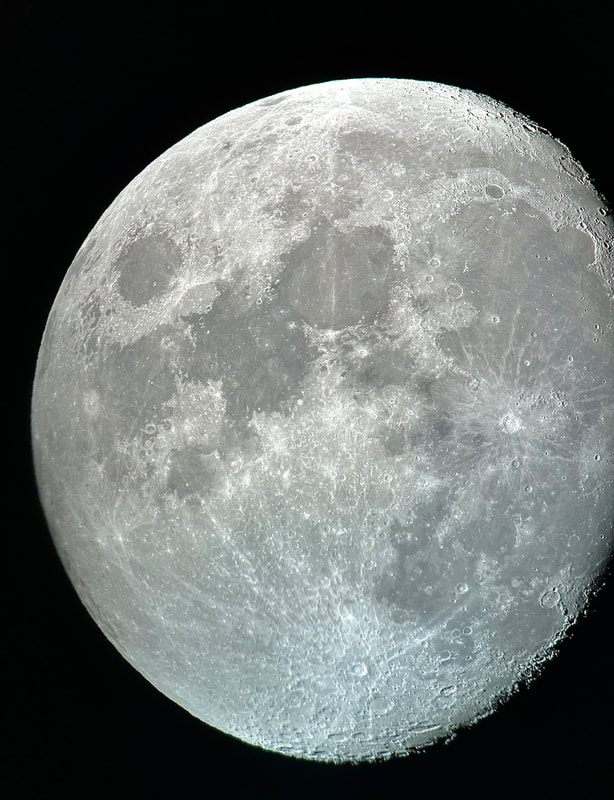
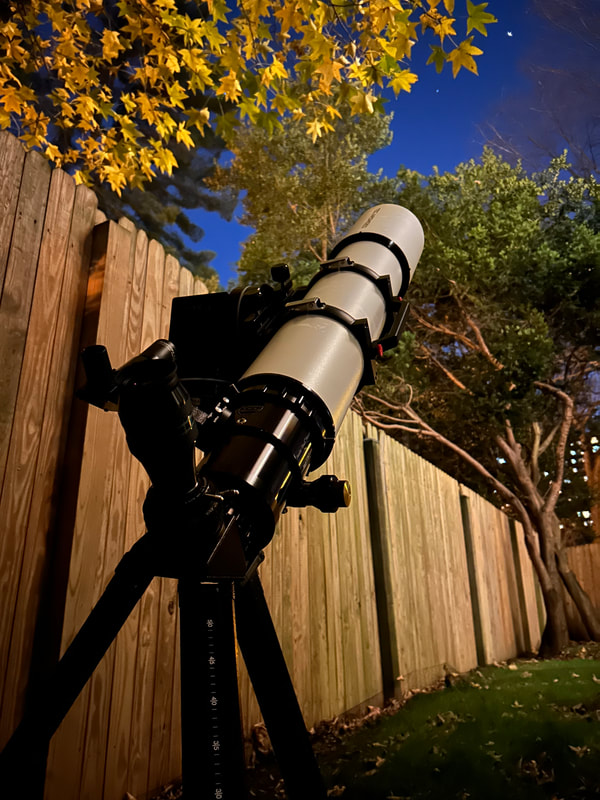
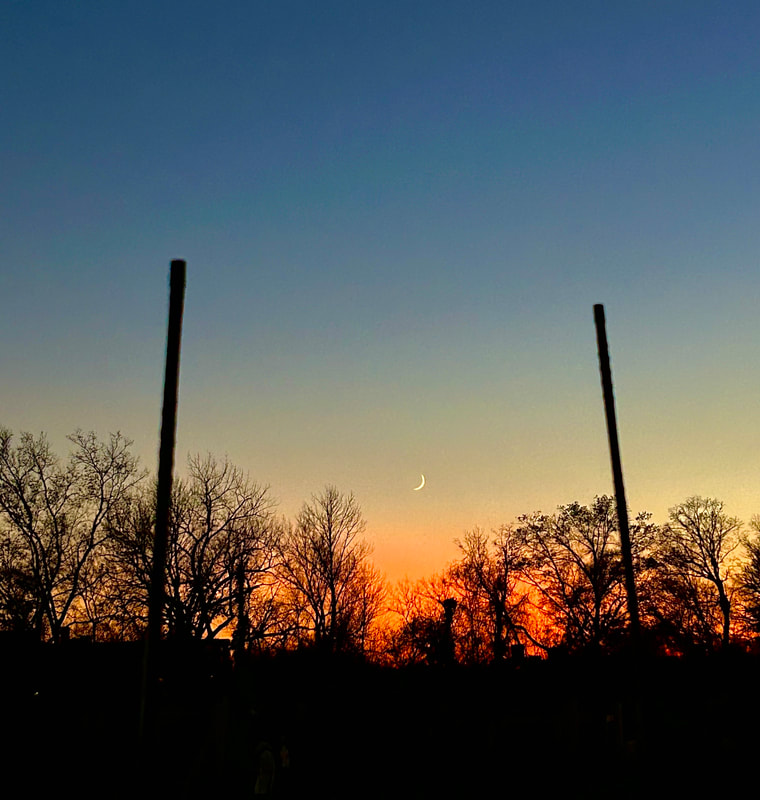
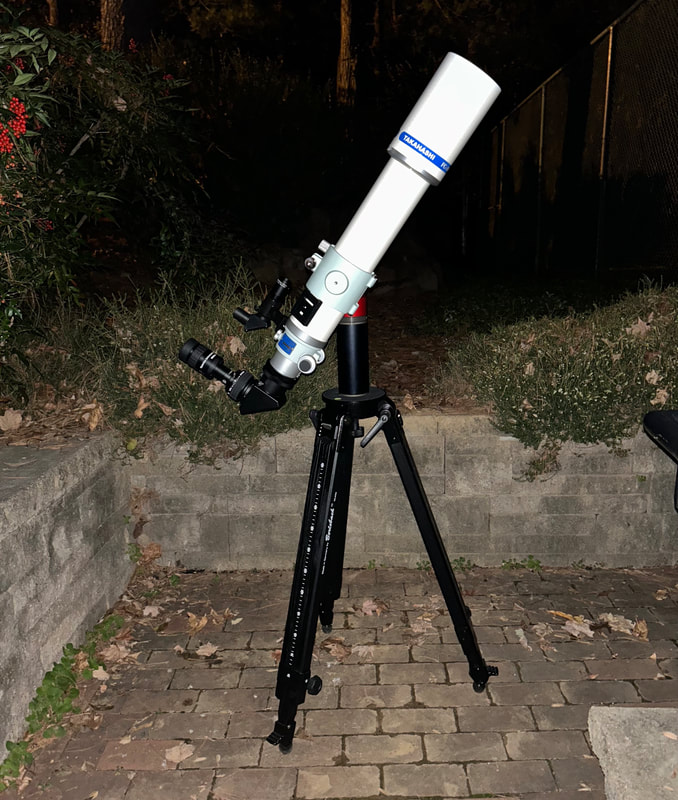
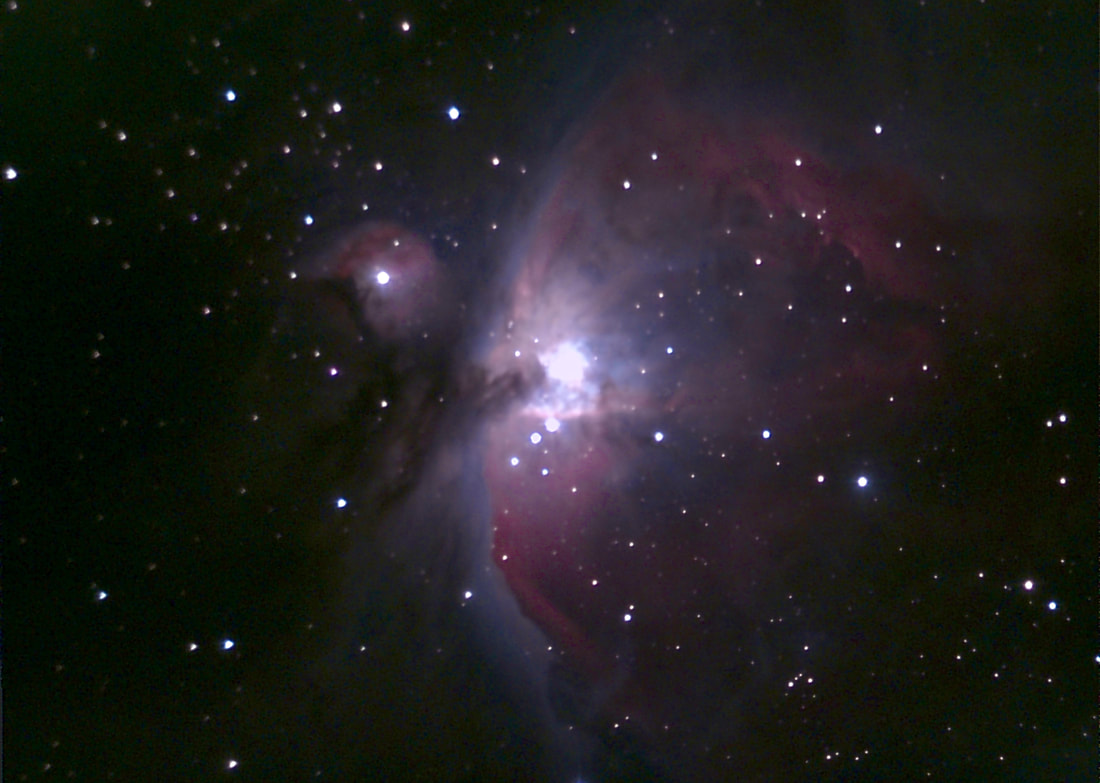
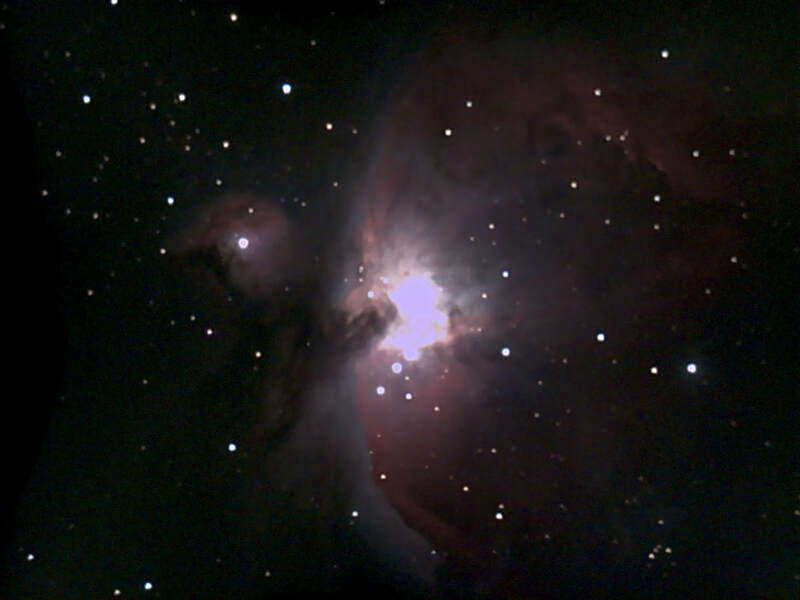
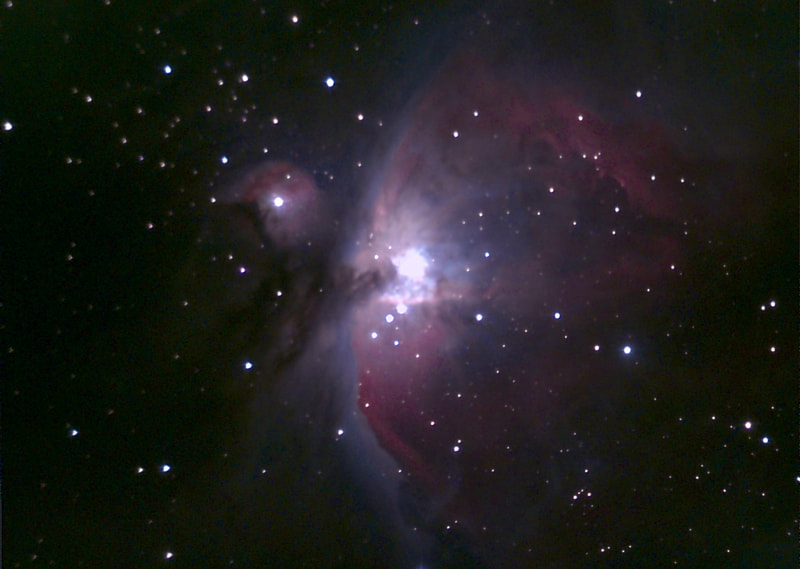
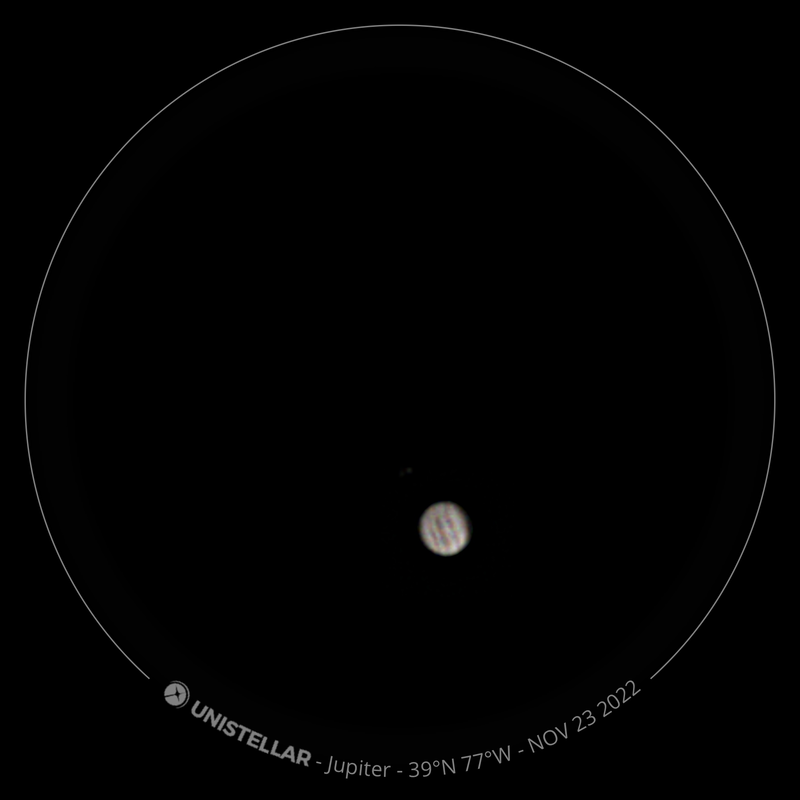
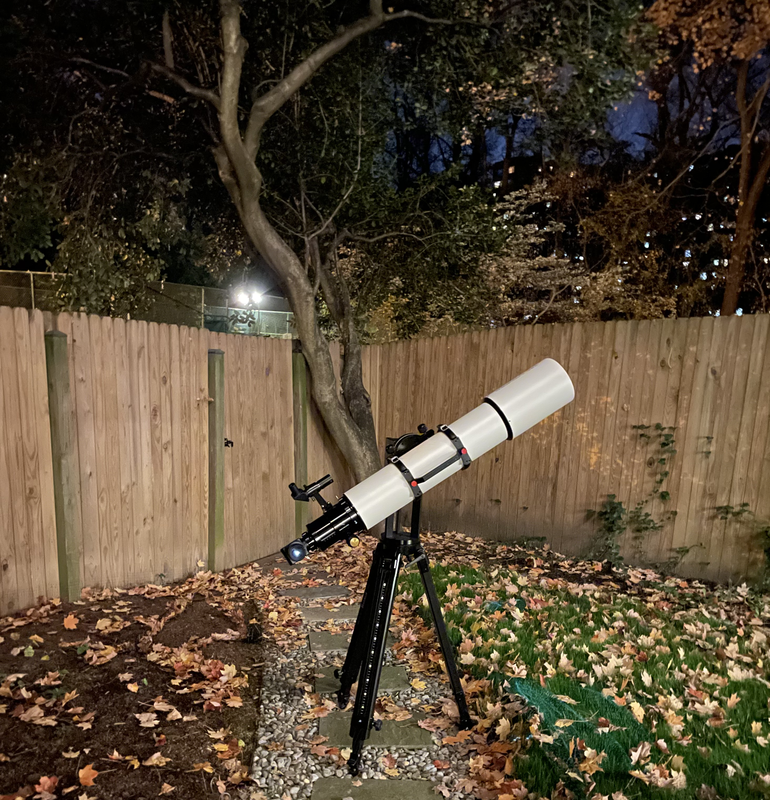
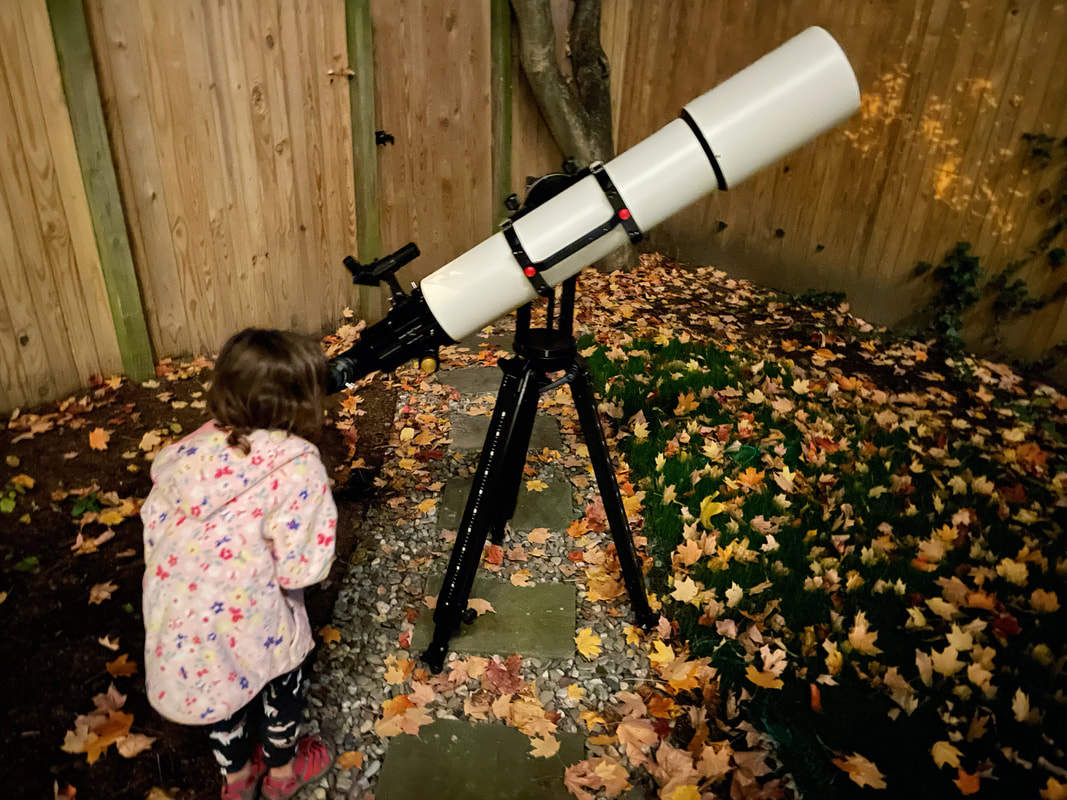
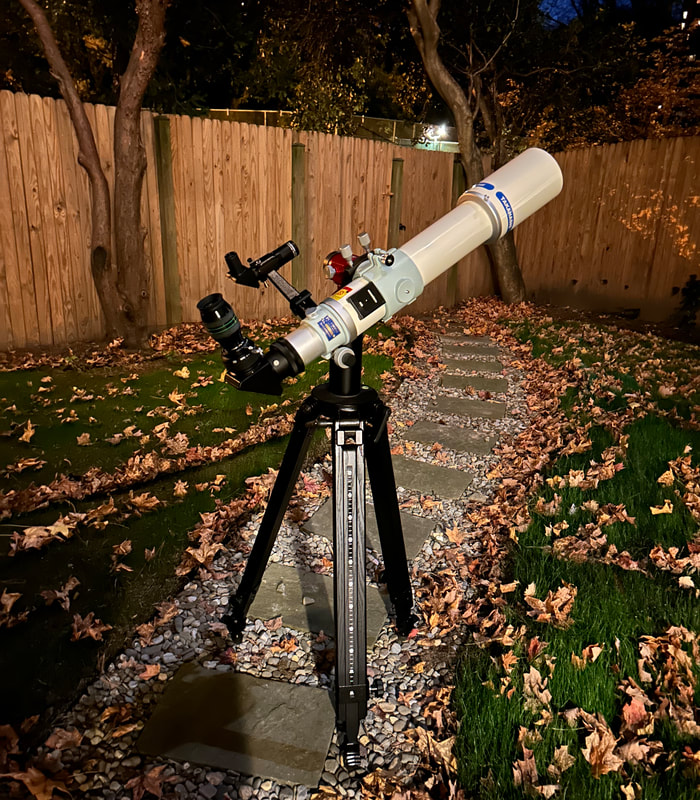
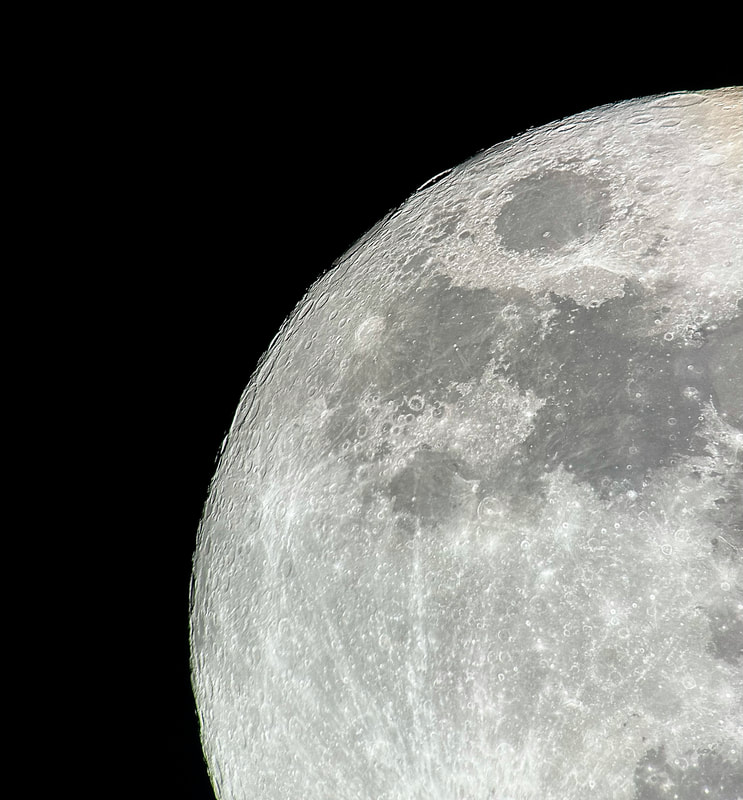
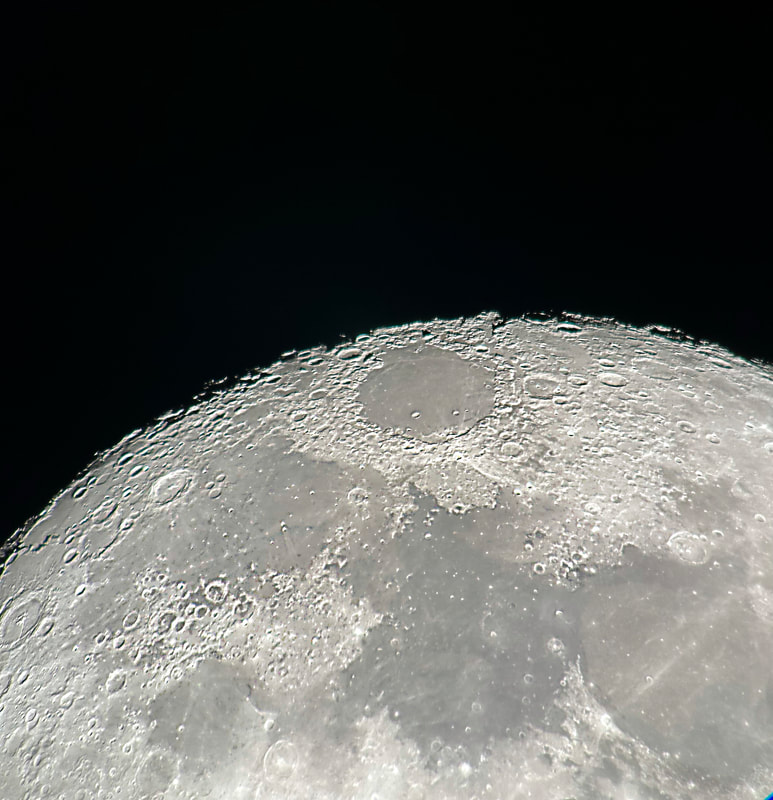
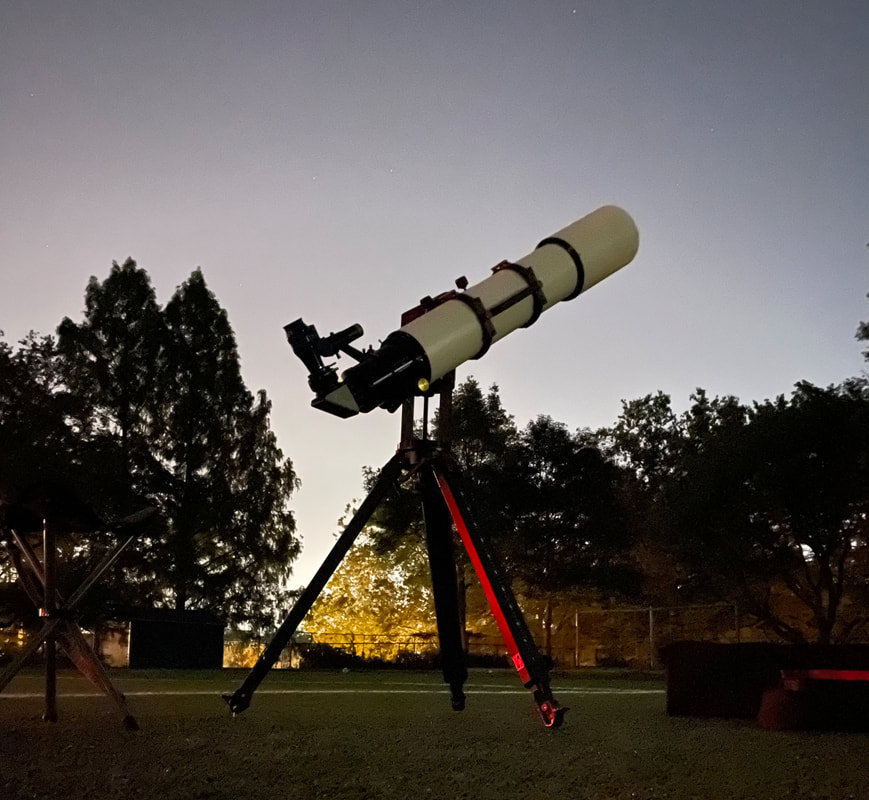
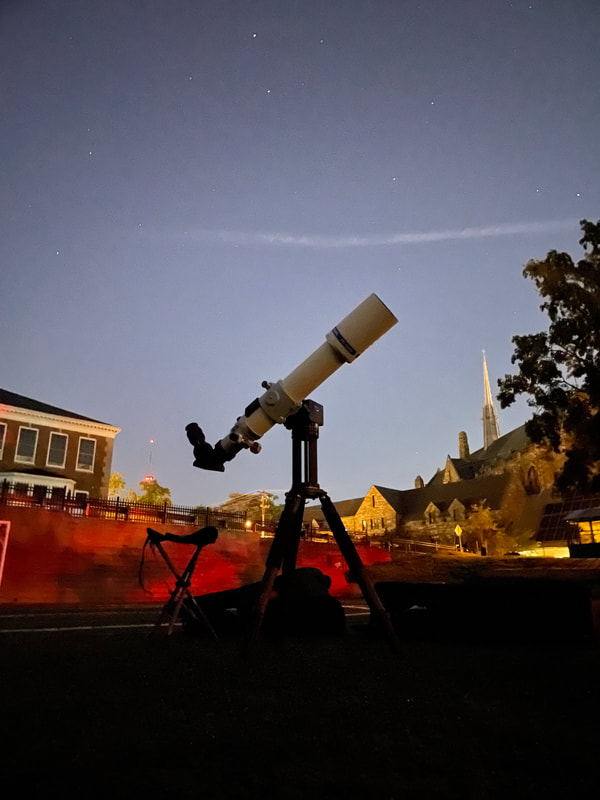
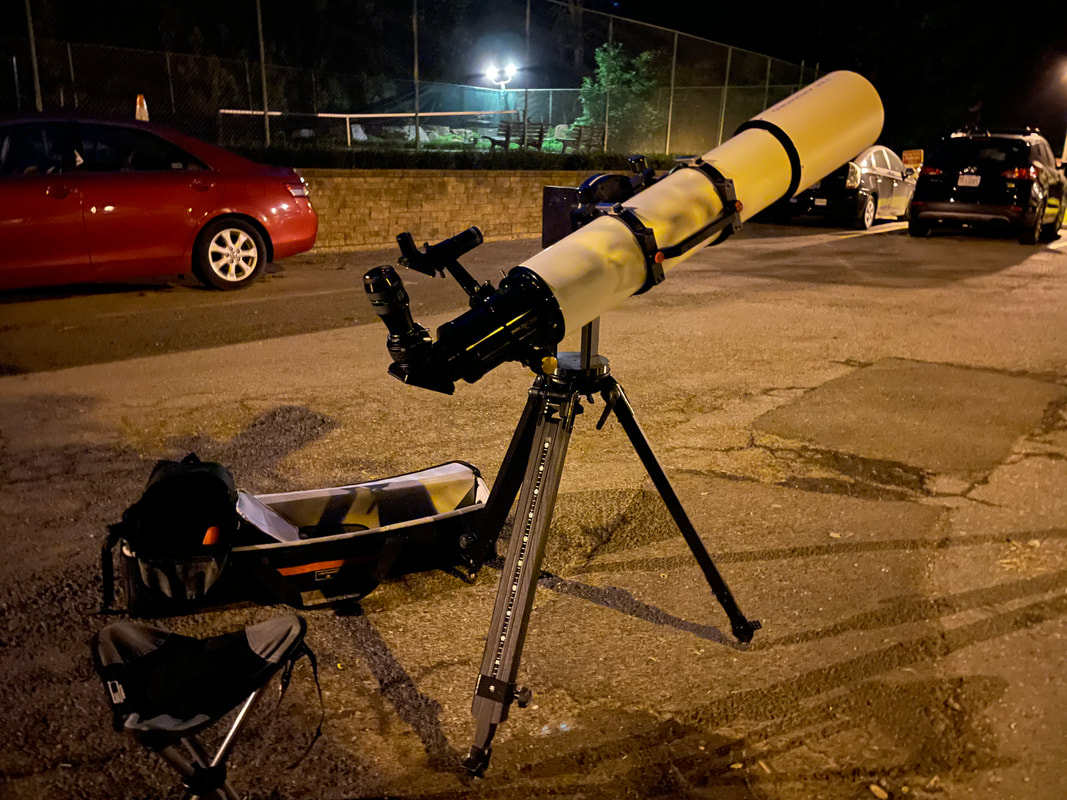
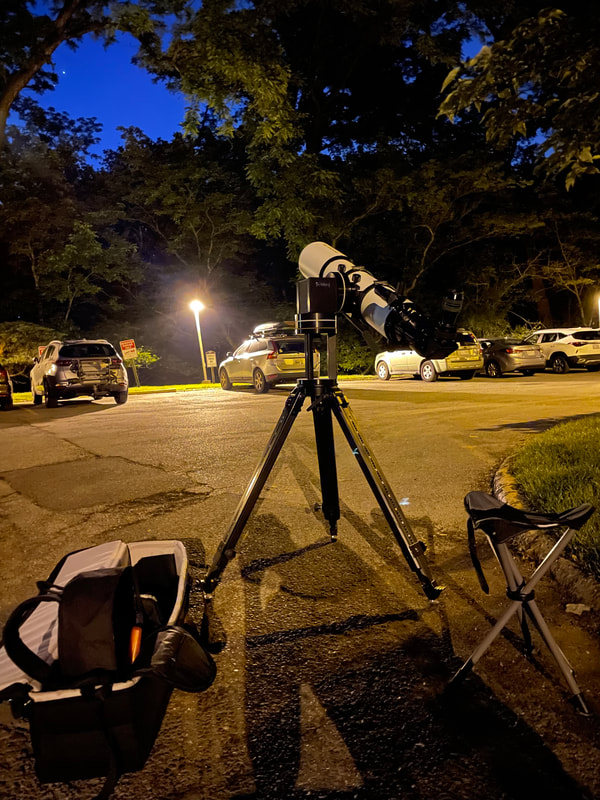
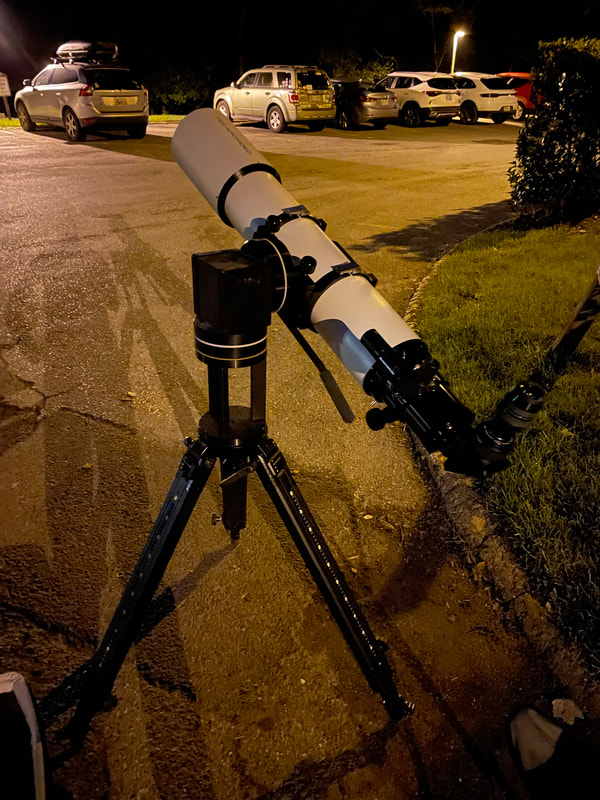
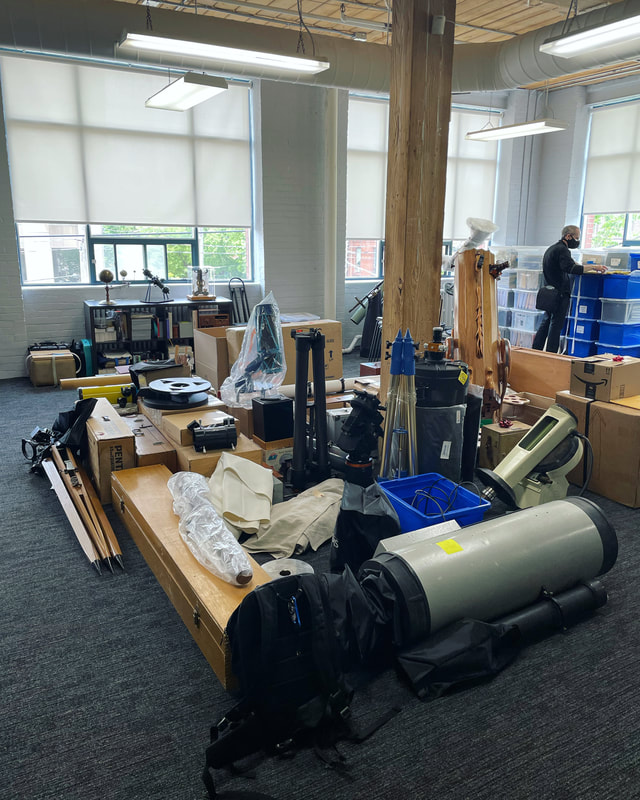
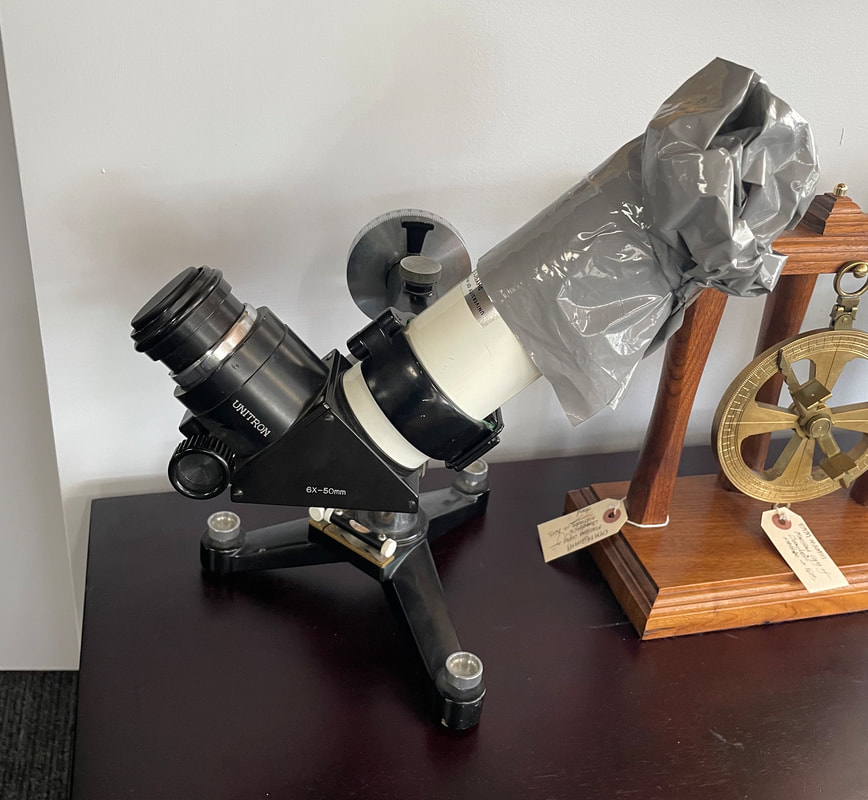
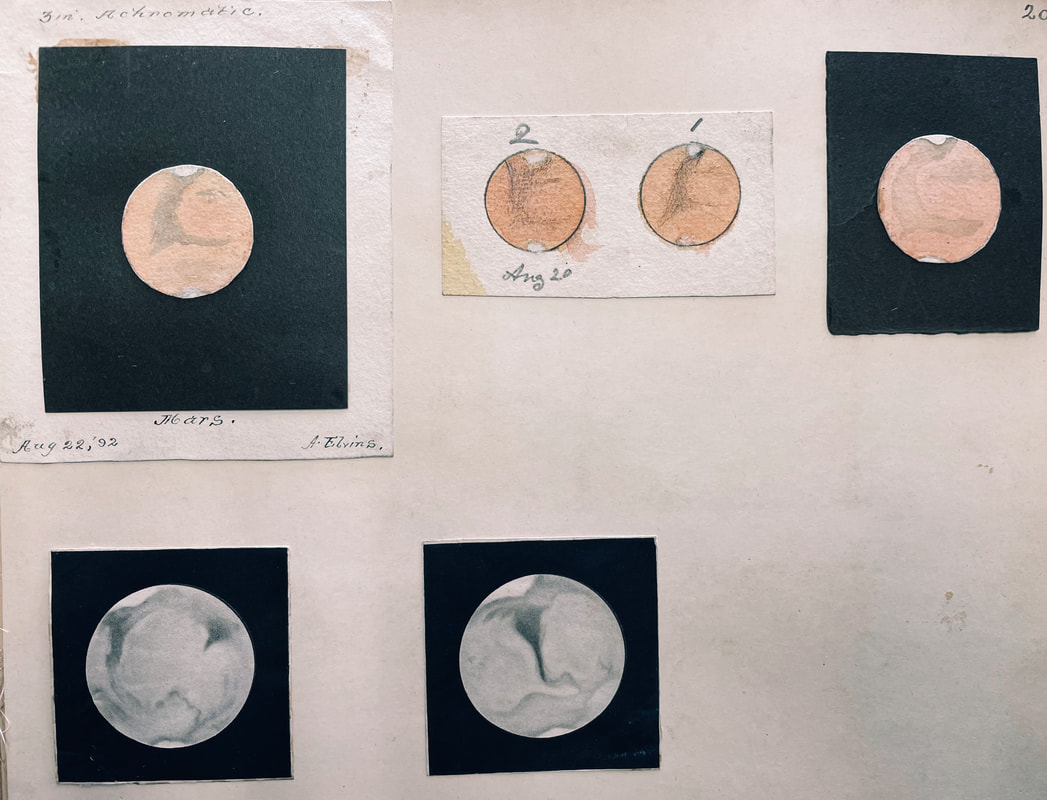
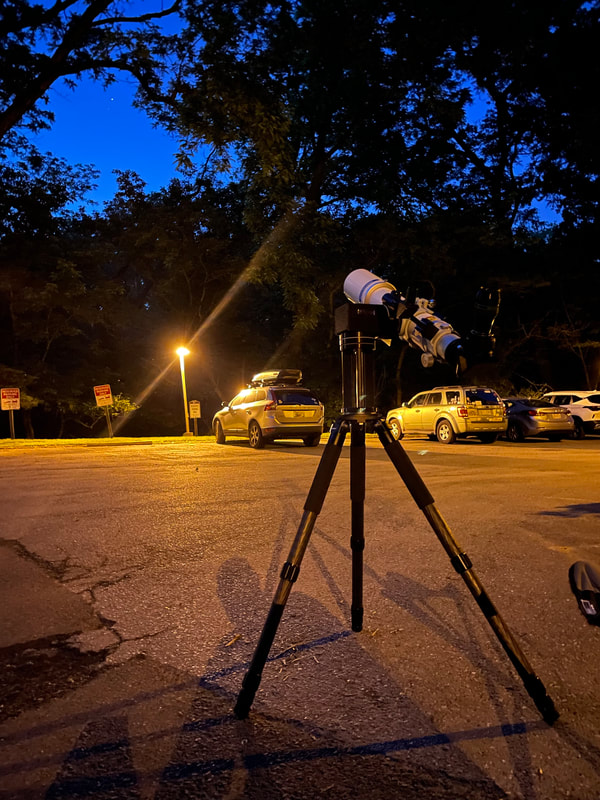
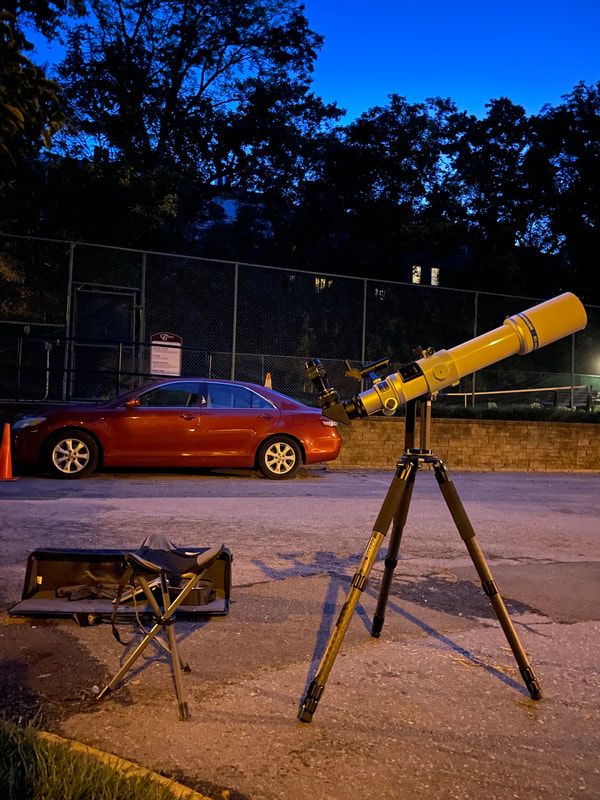
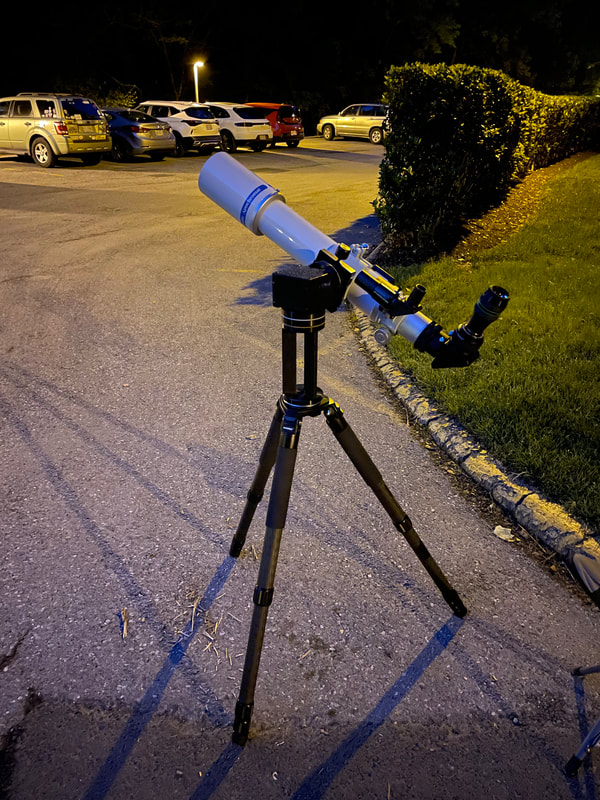
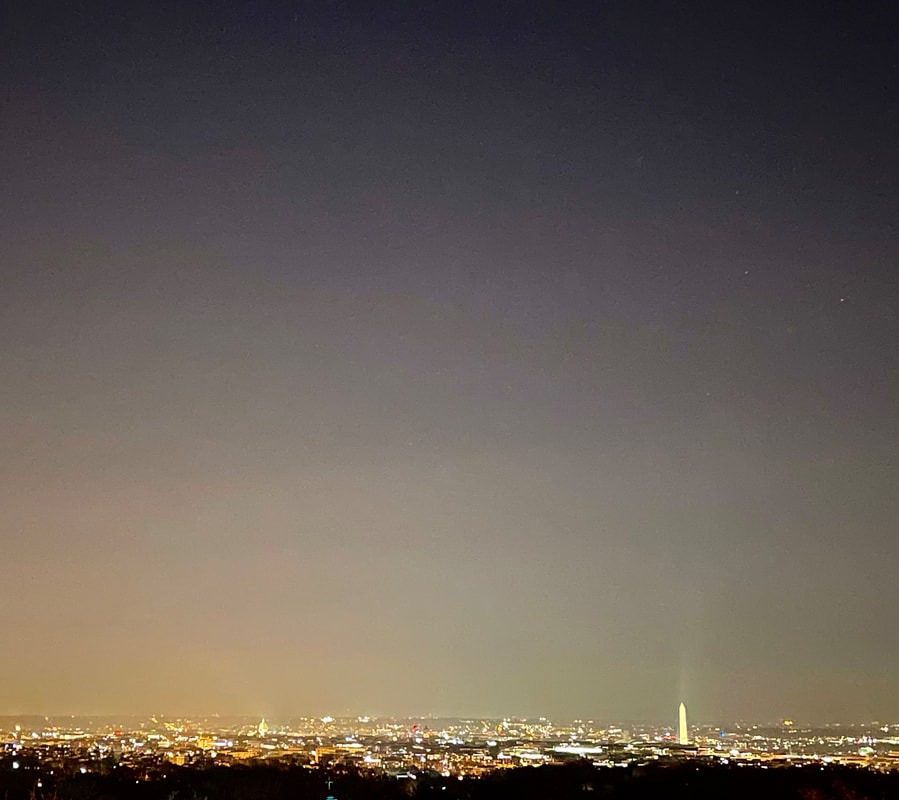
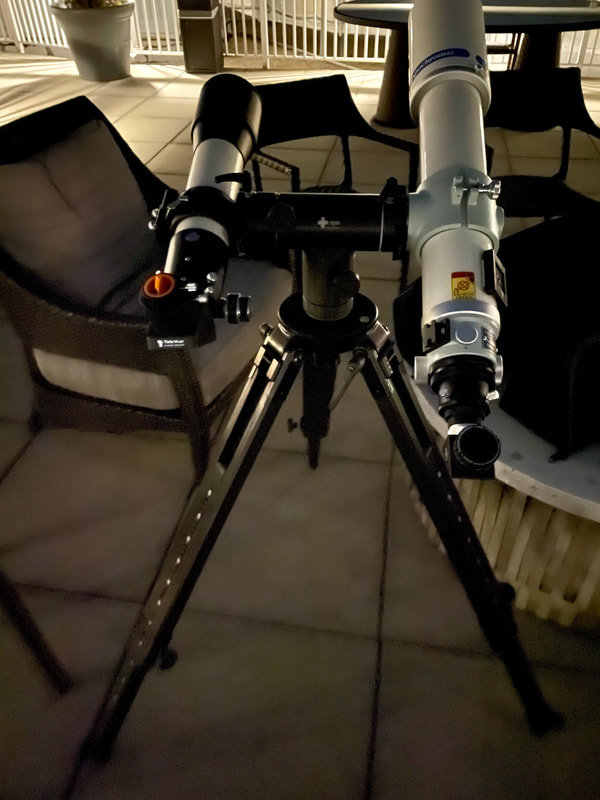
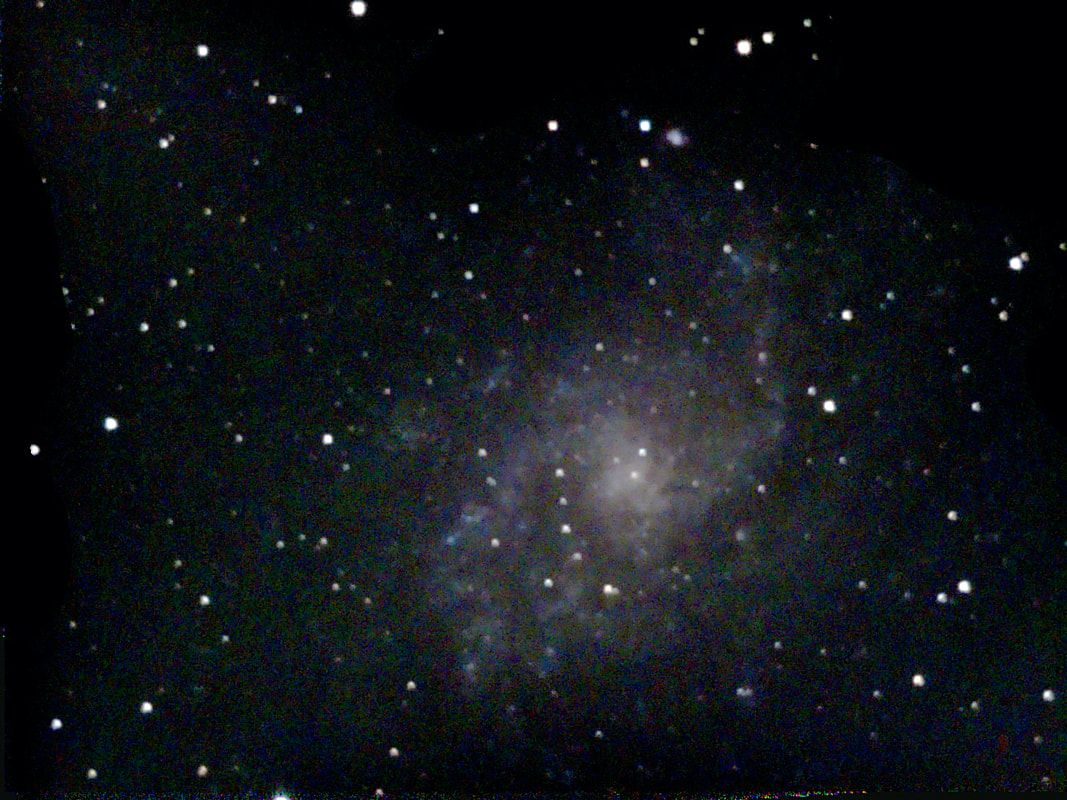
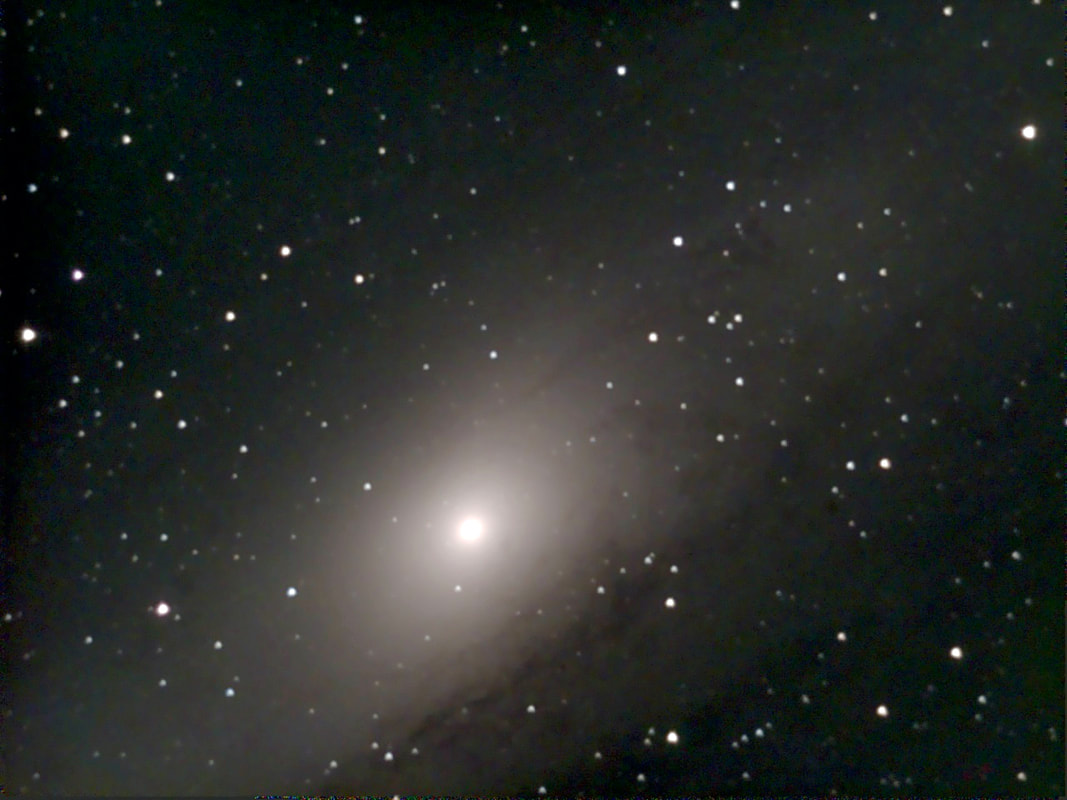
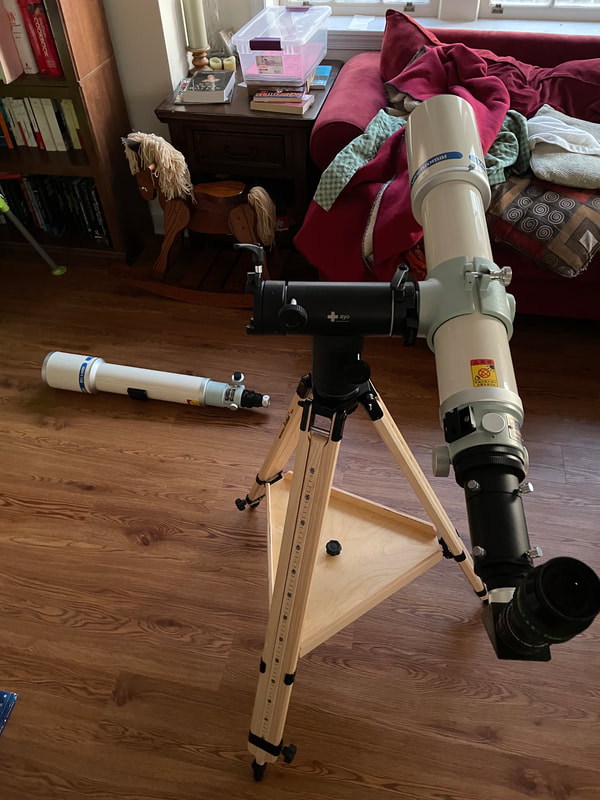
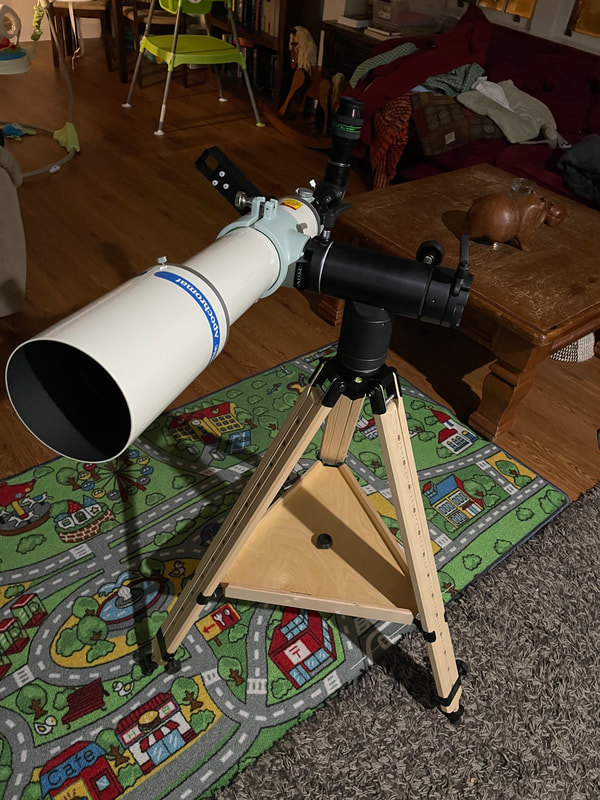
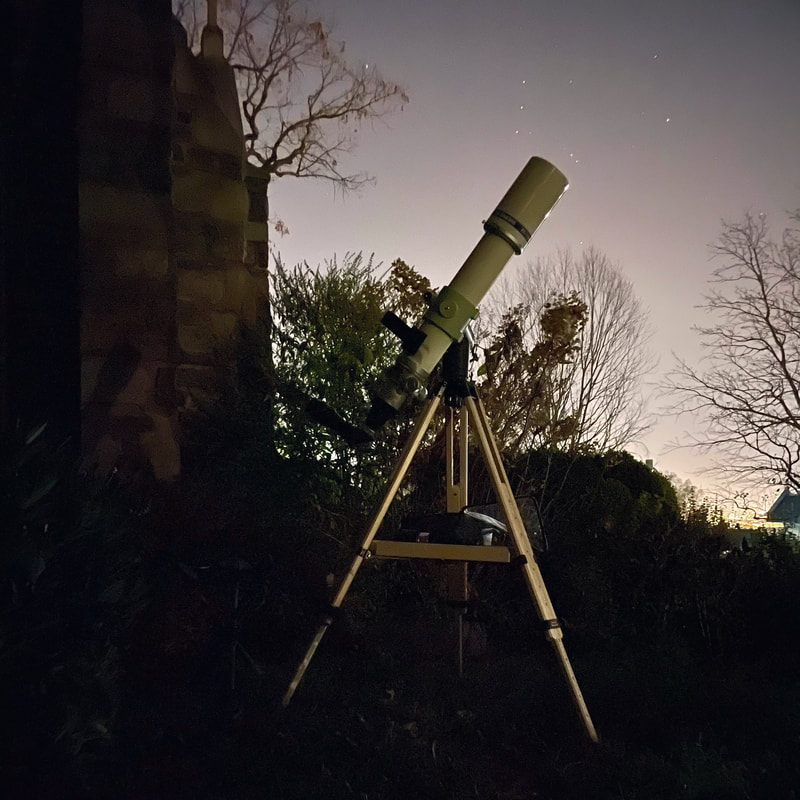
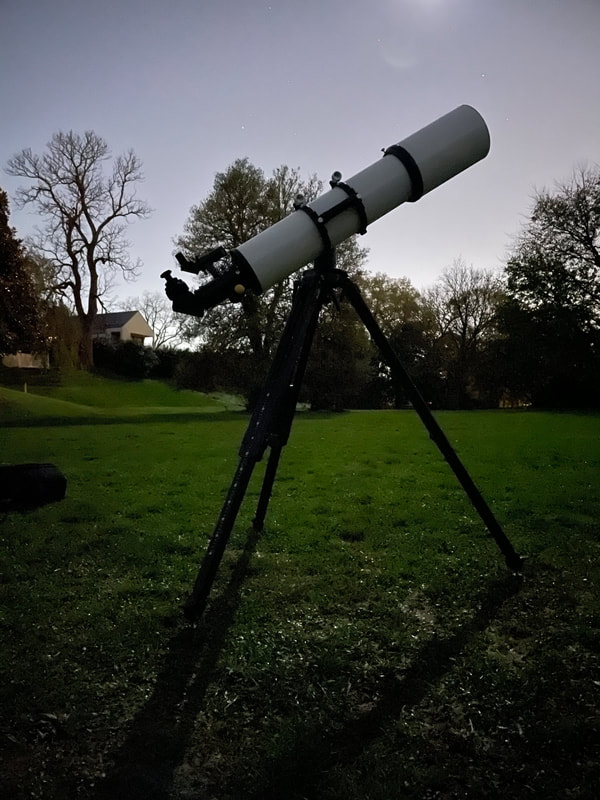
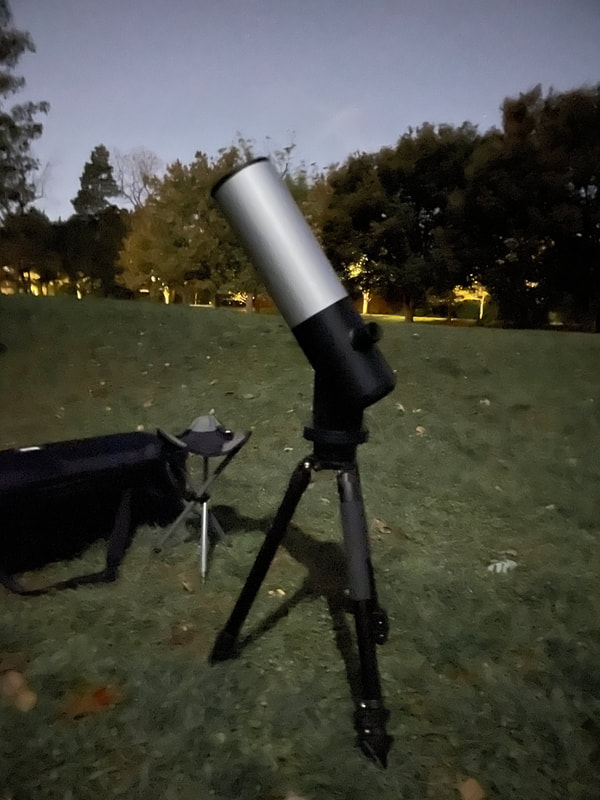
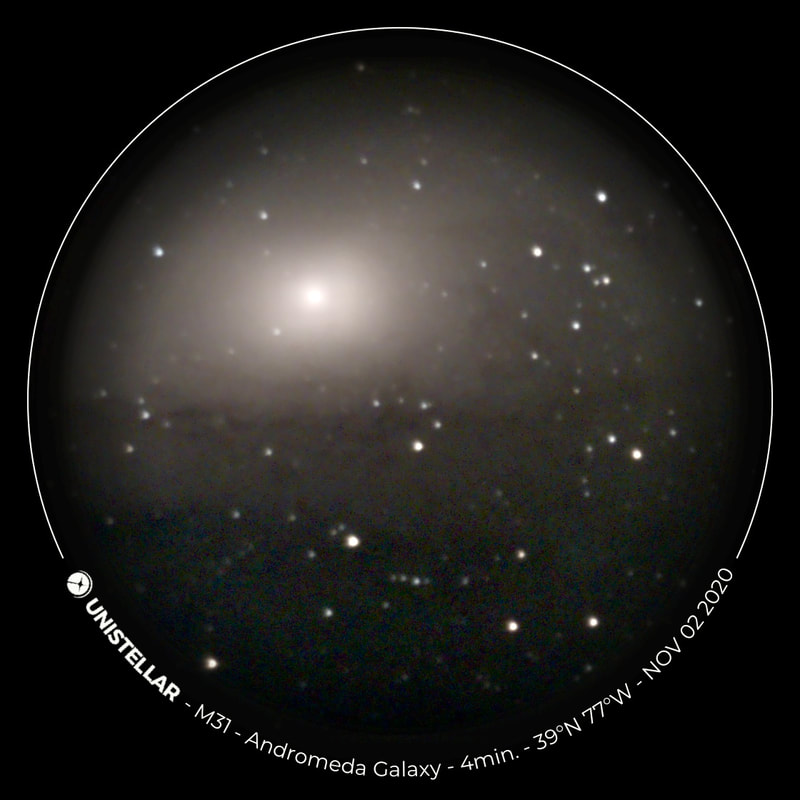
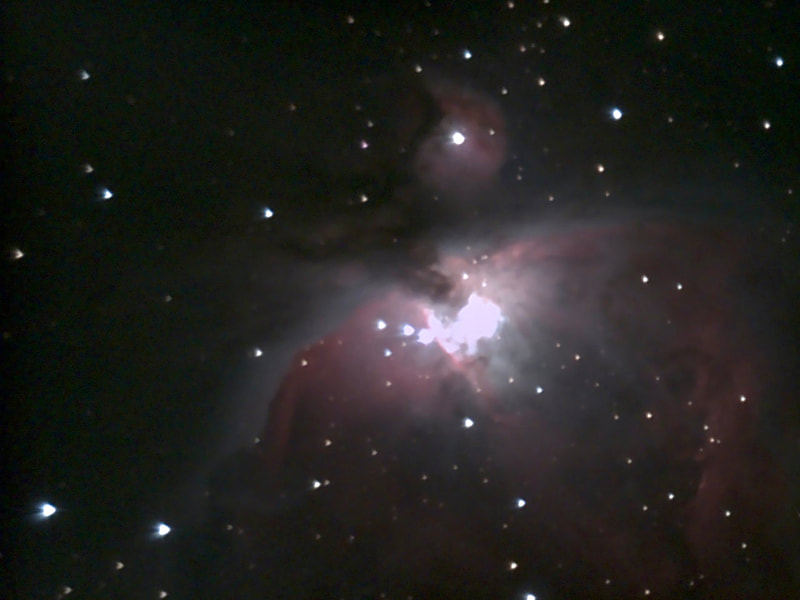
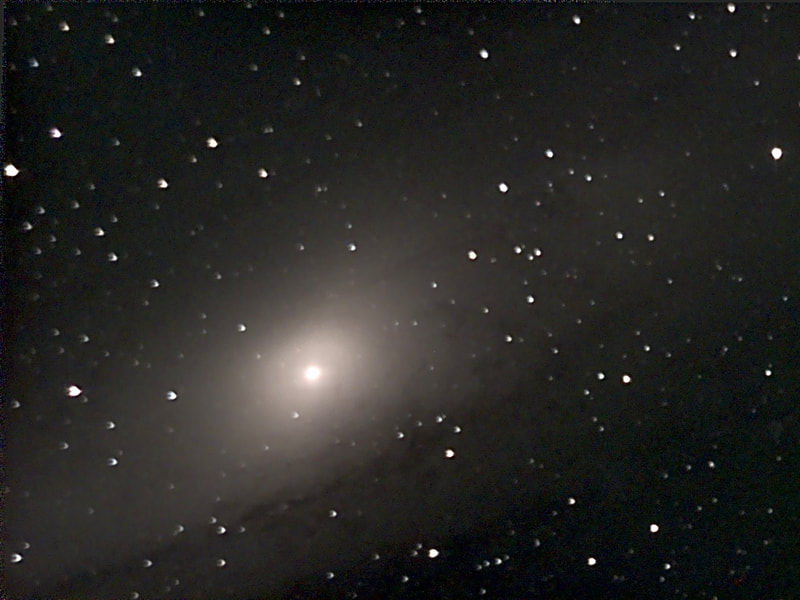
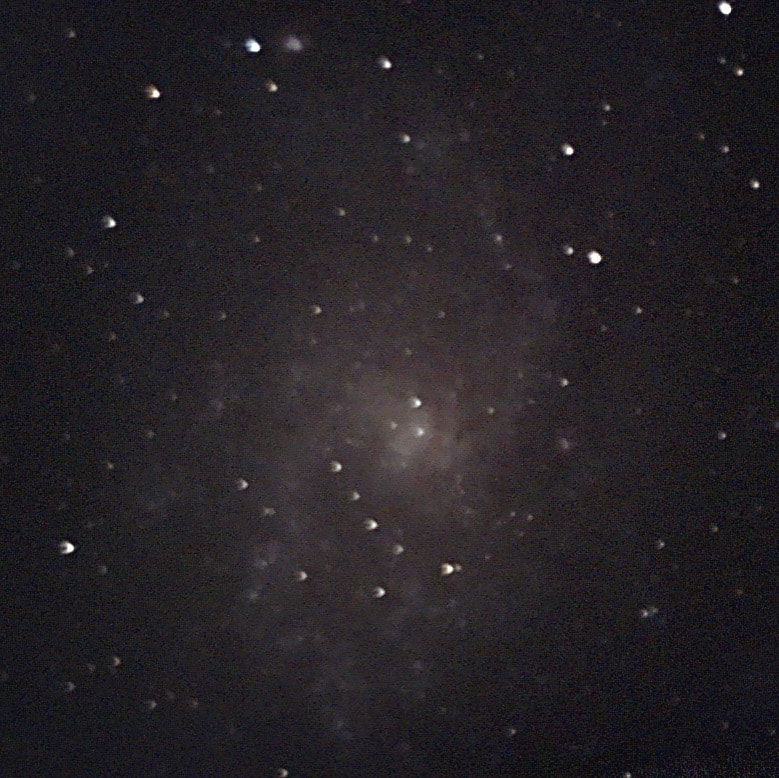
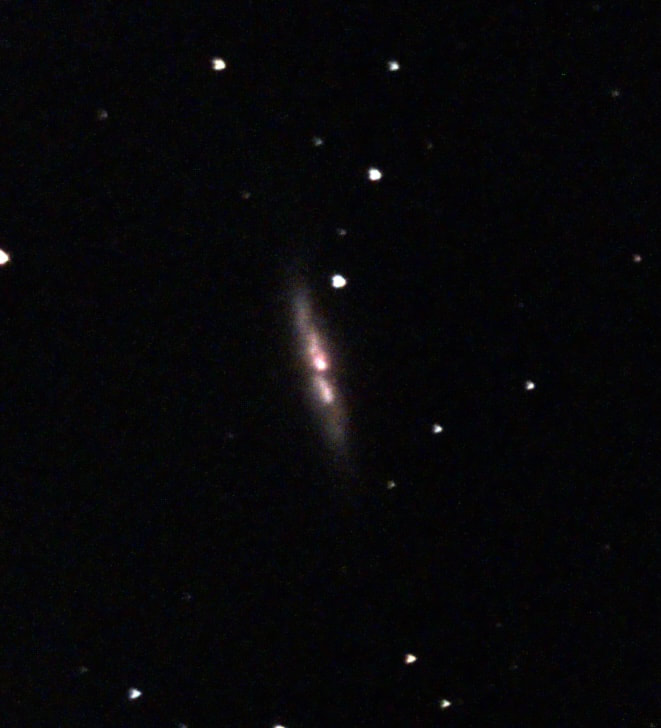
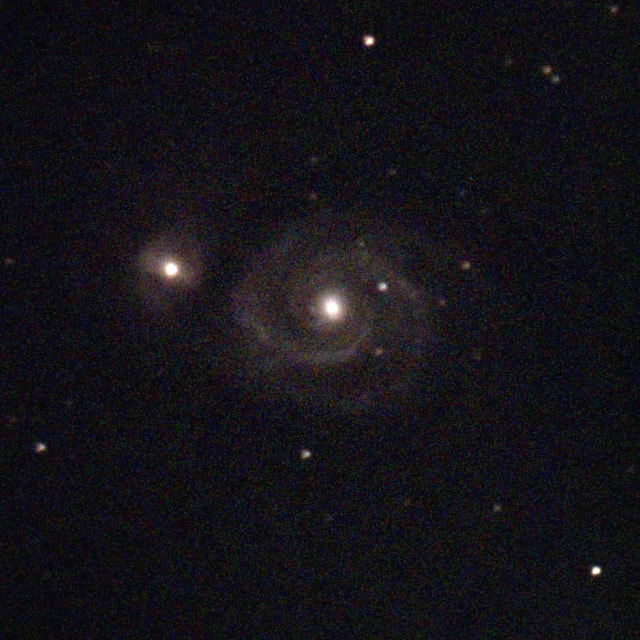
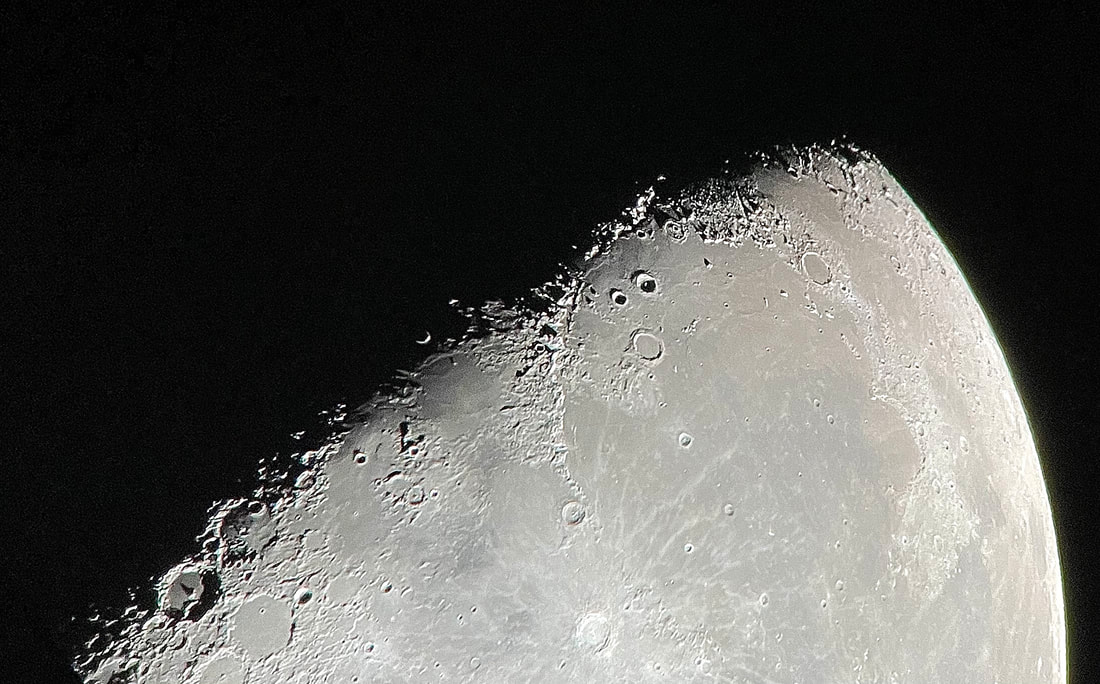
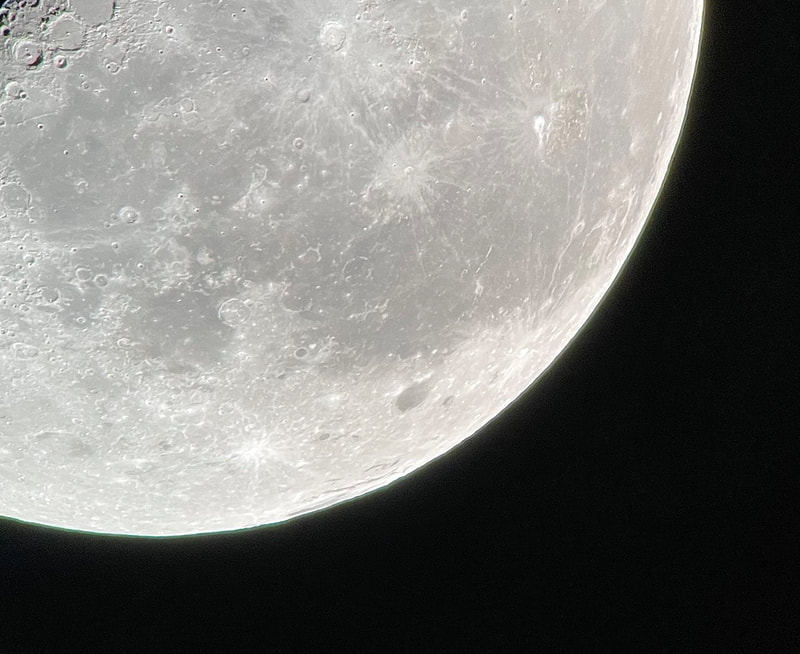
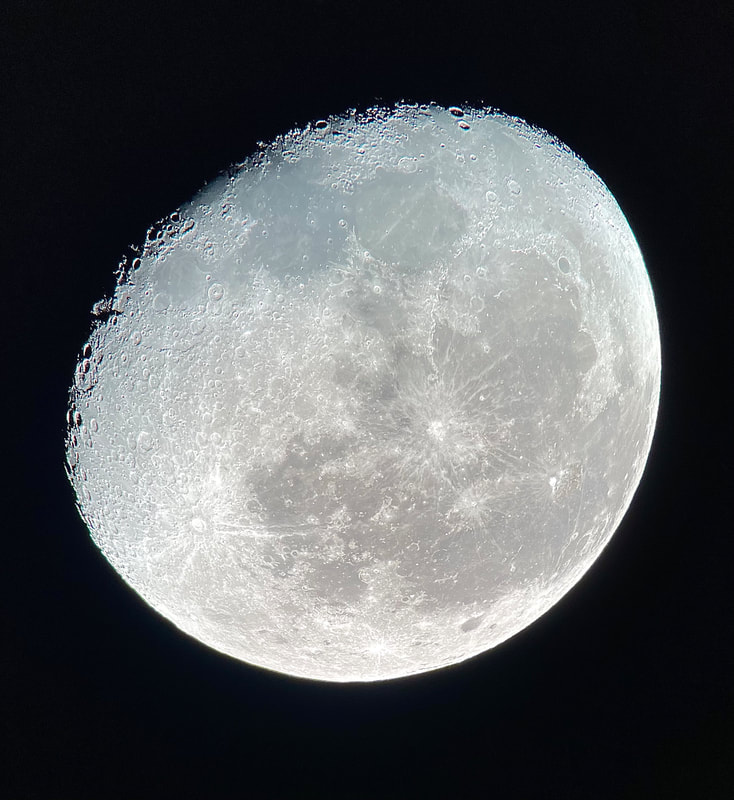
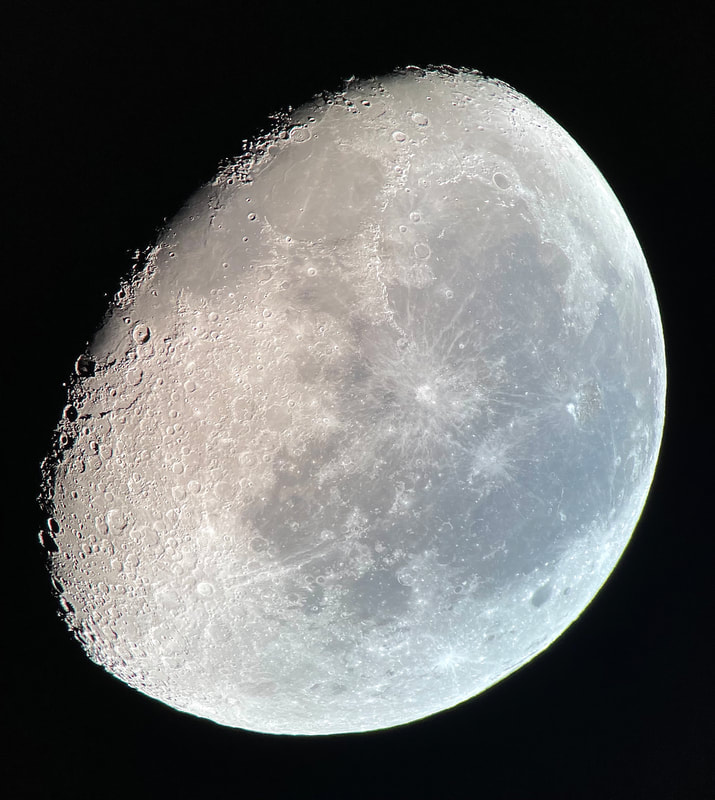
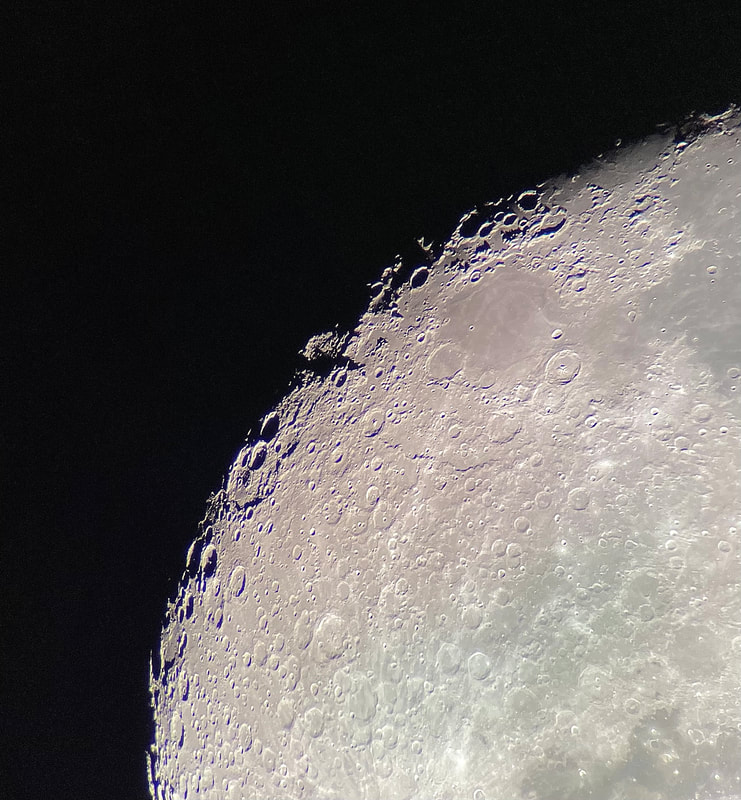

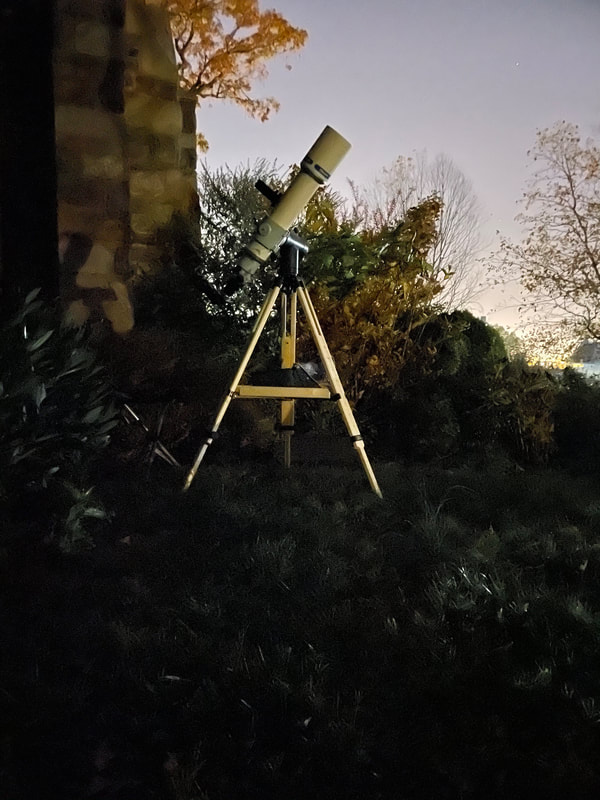

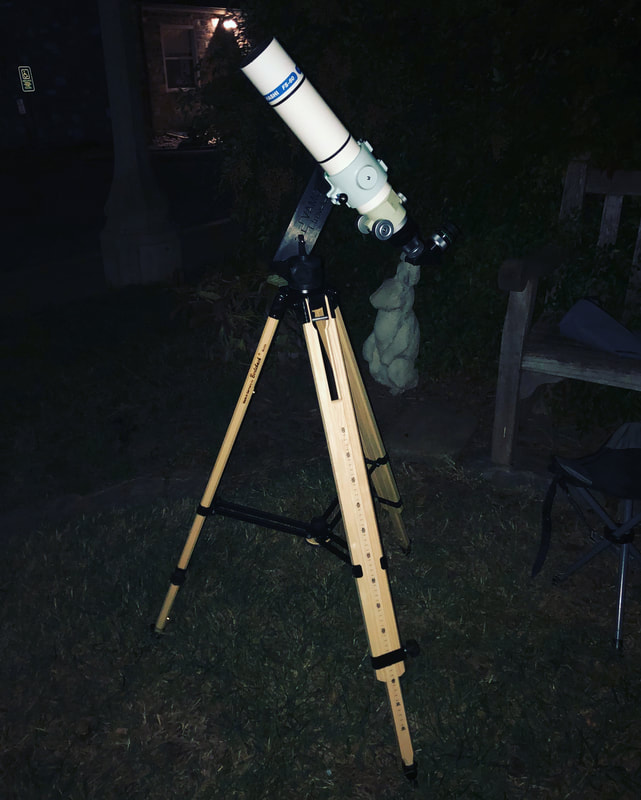
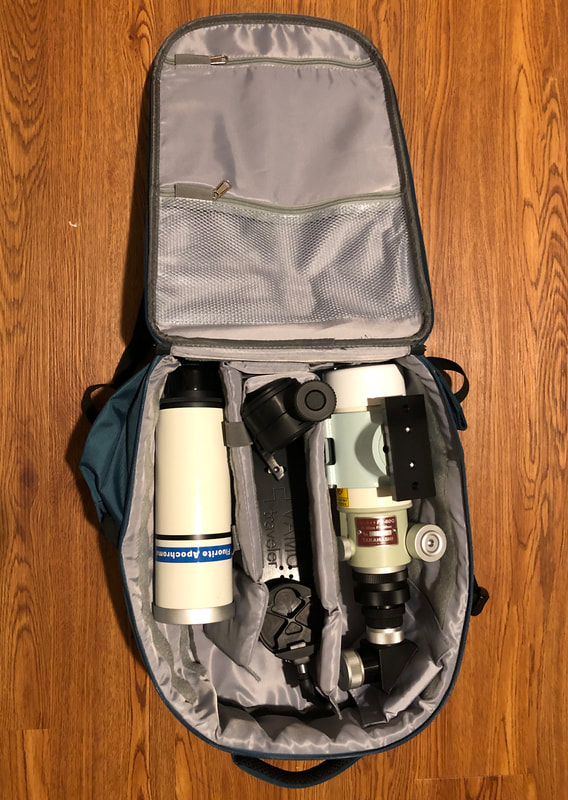
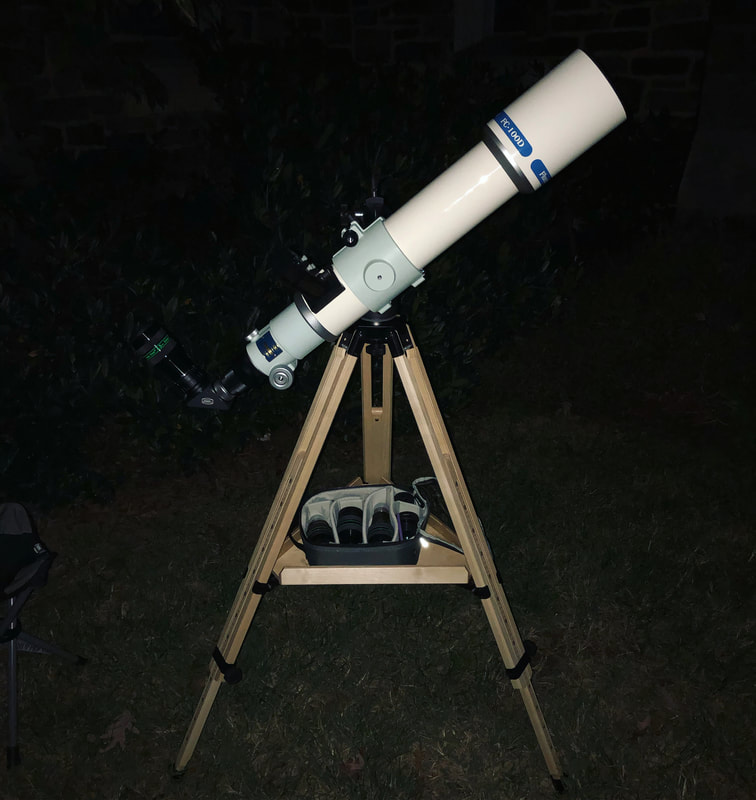

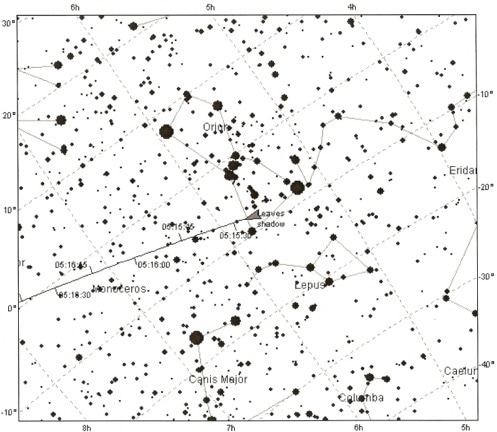
 RSS Feed
RSS Feed